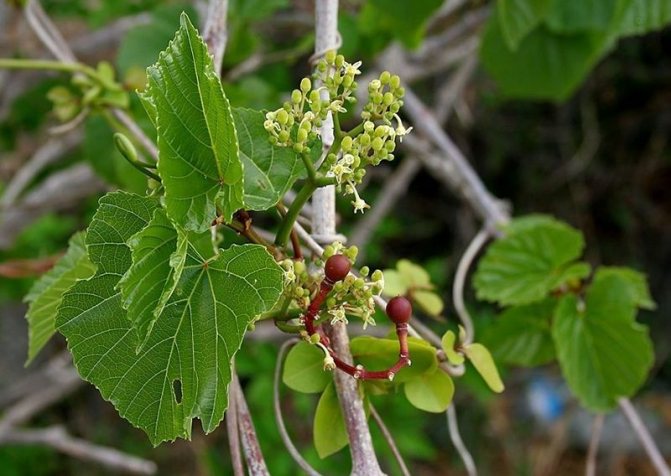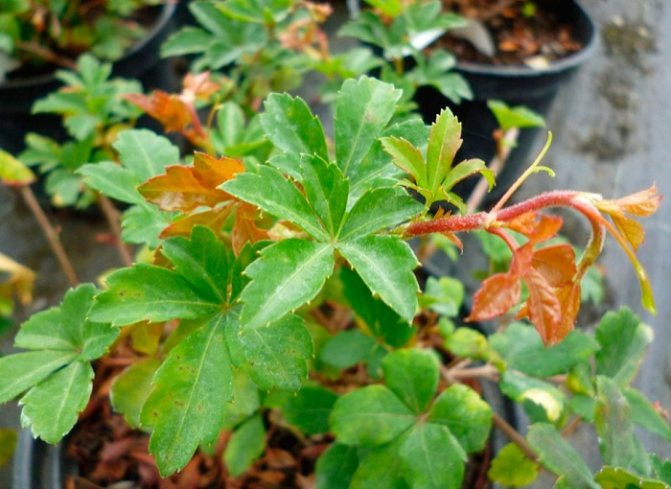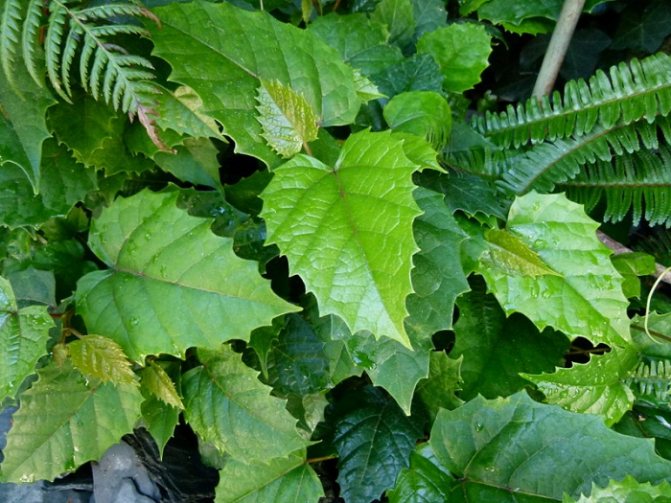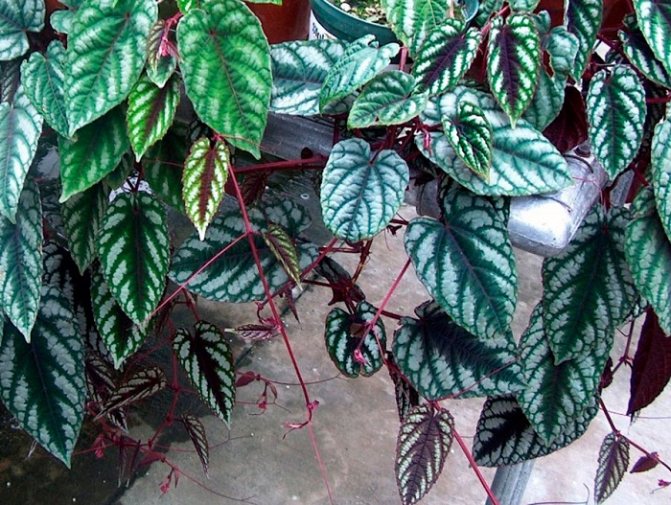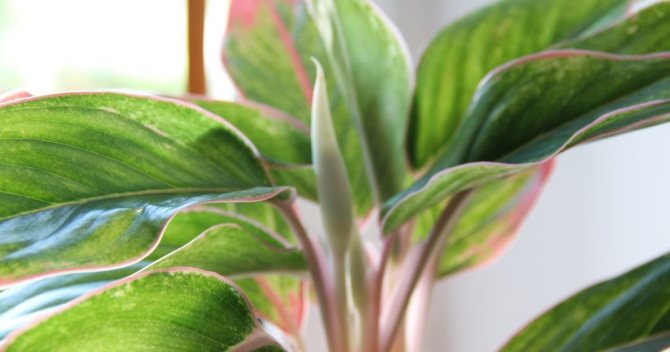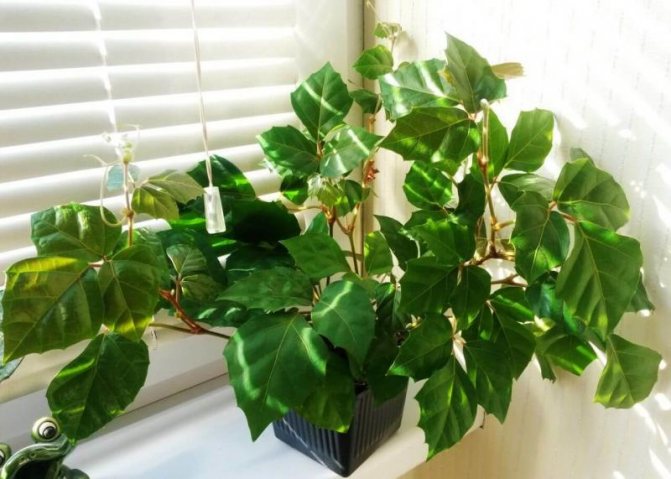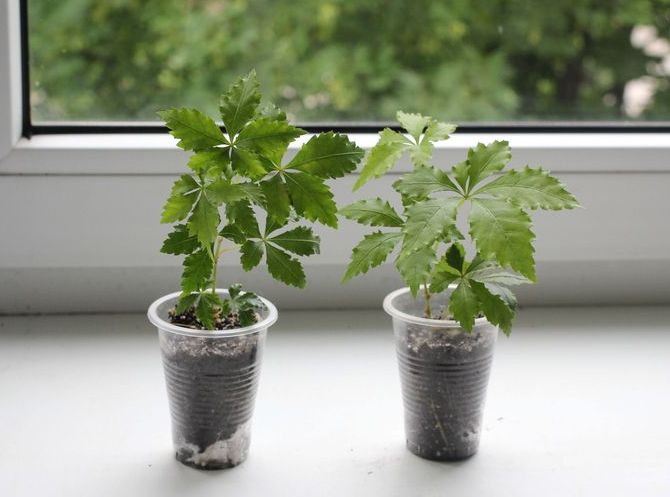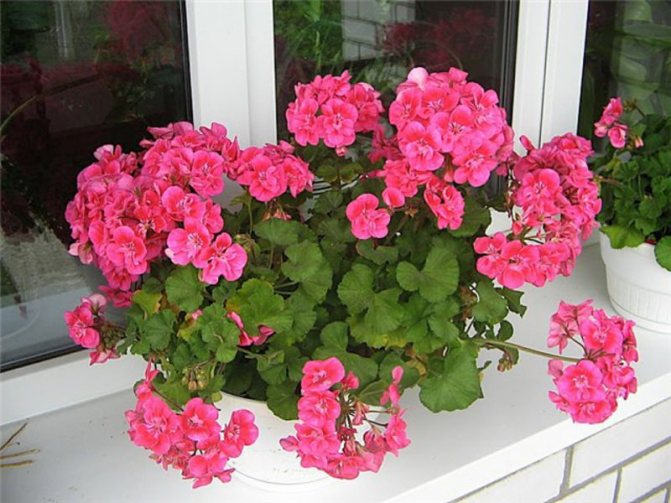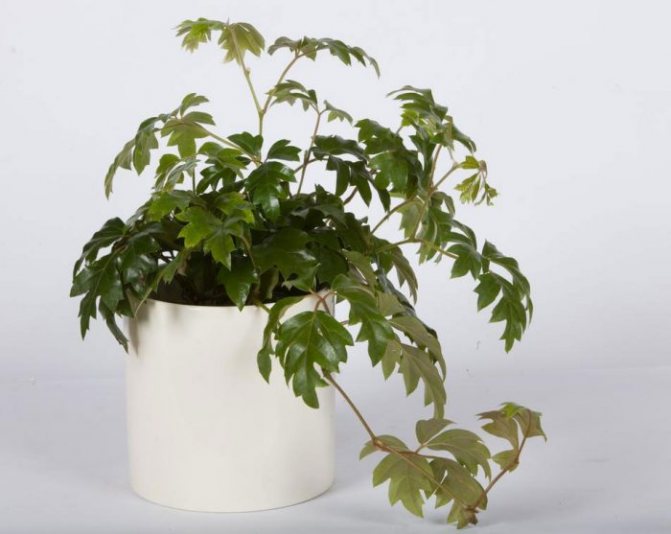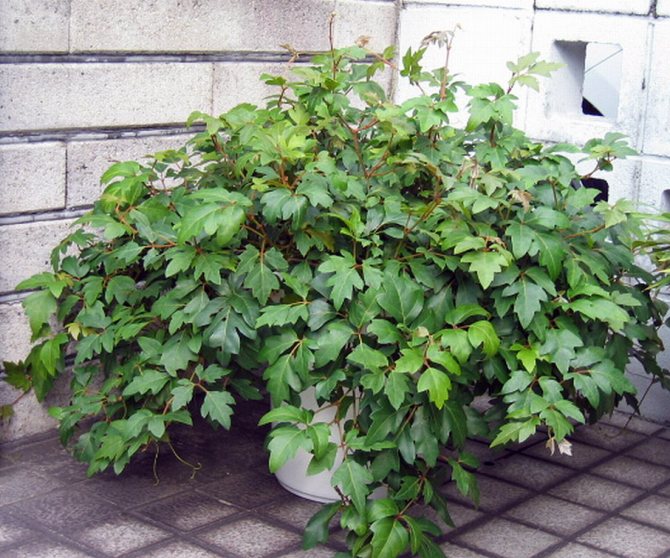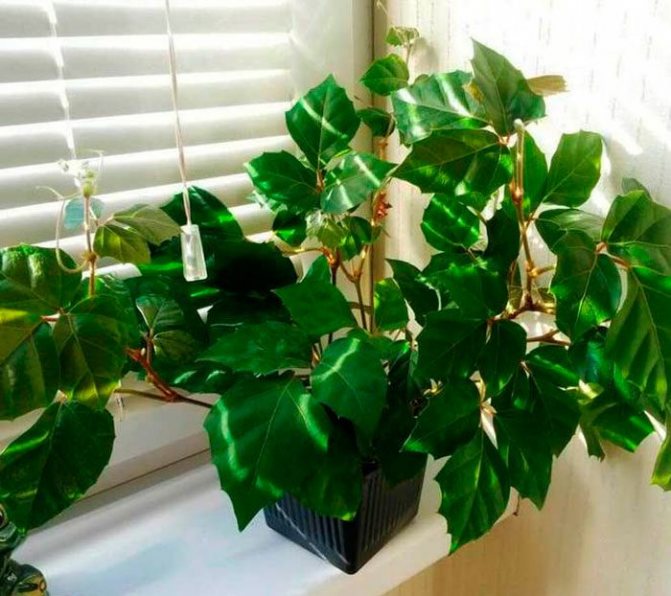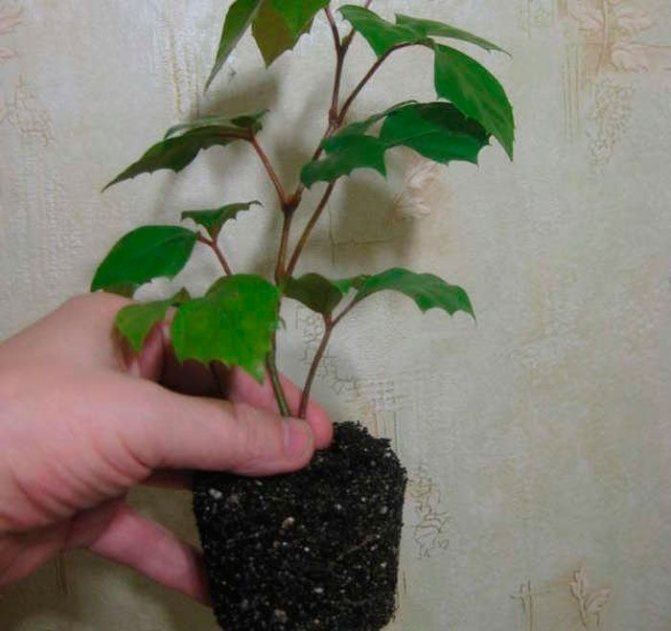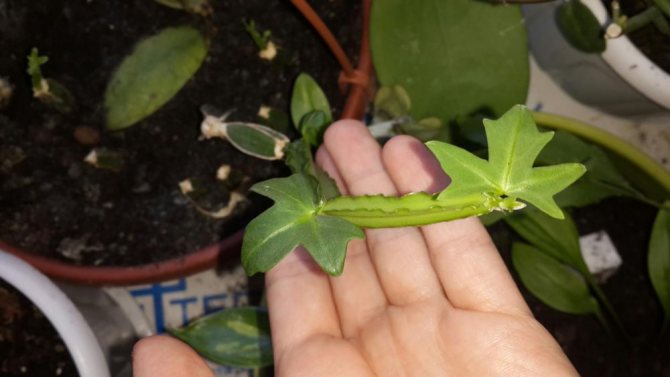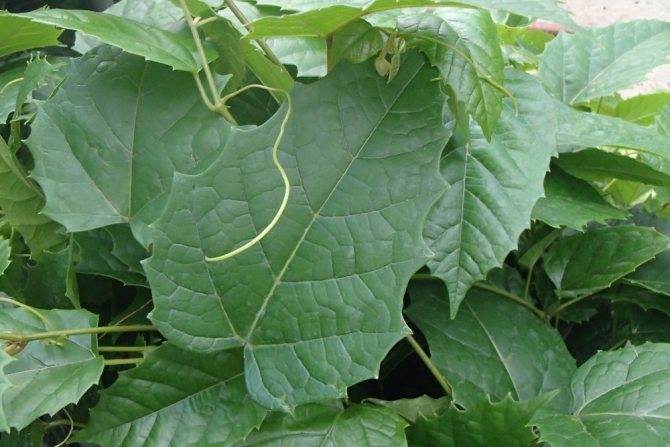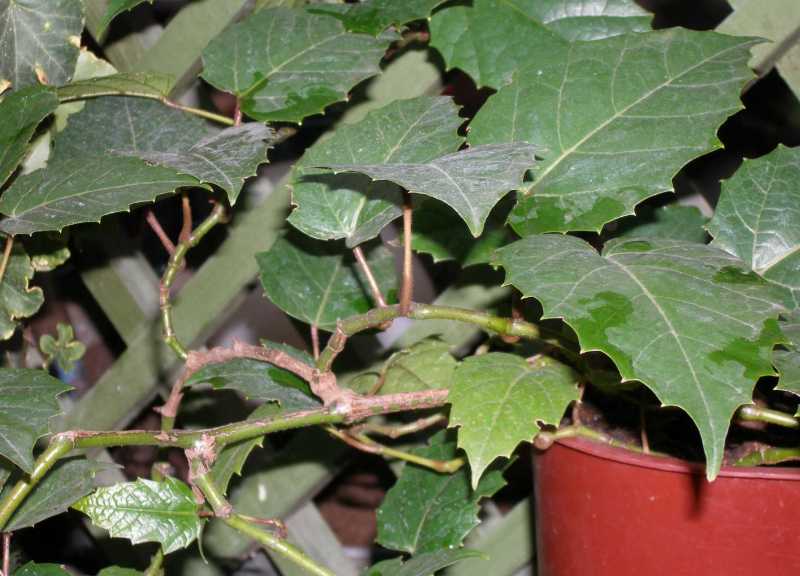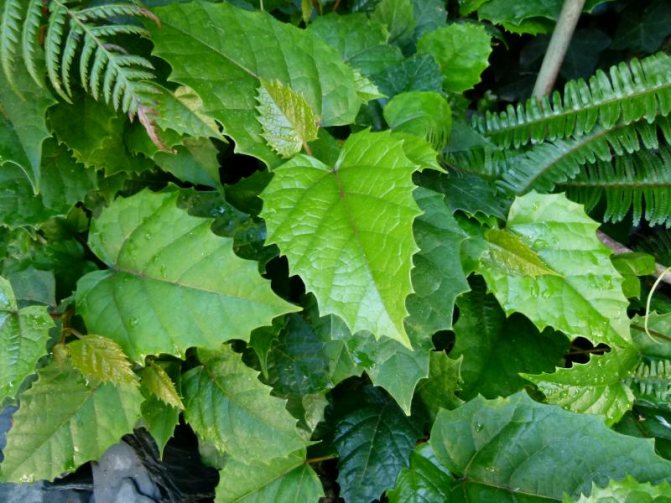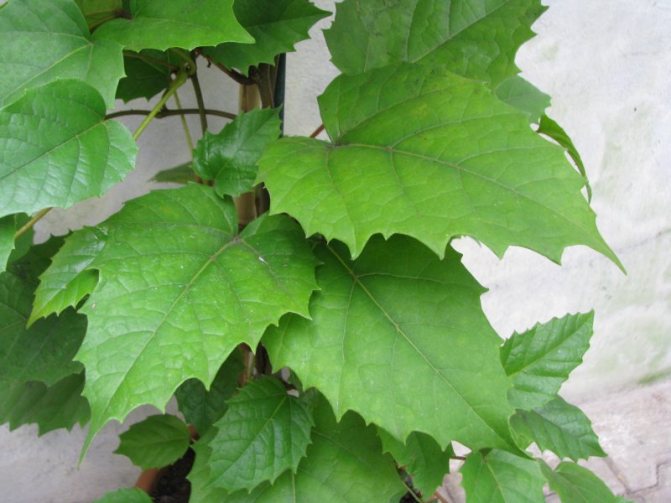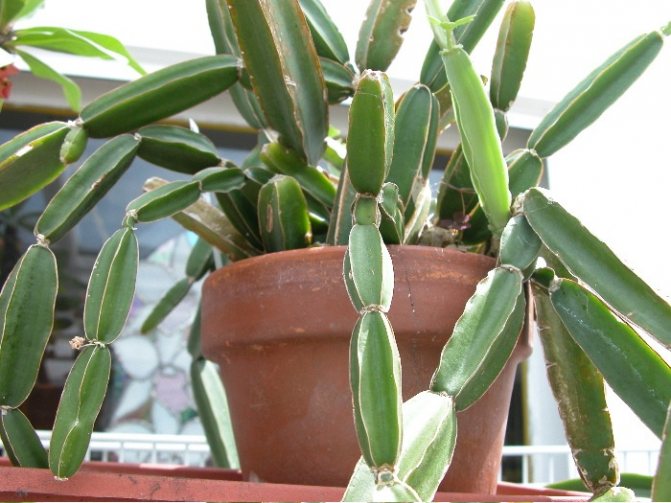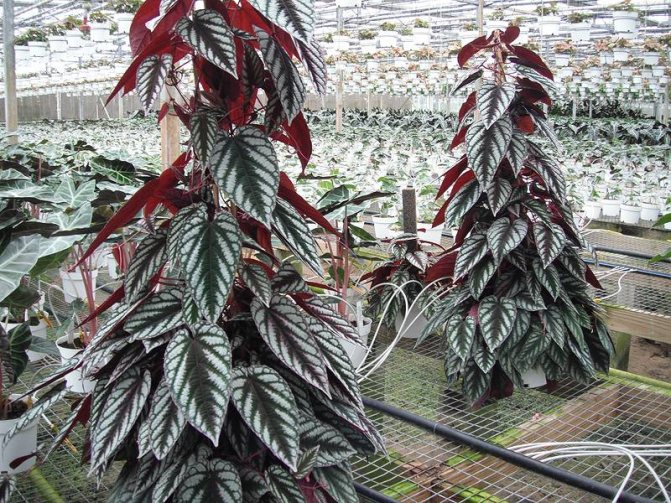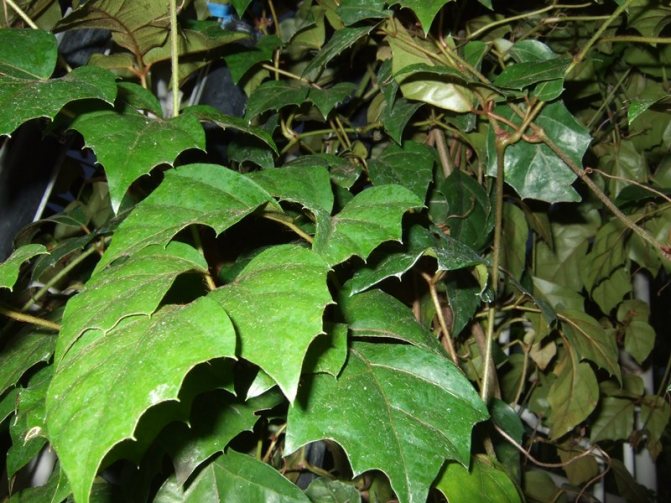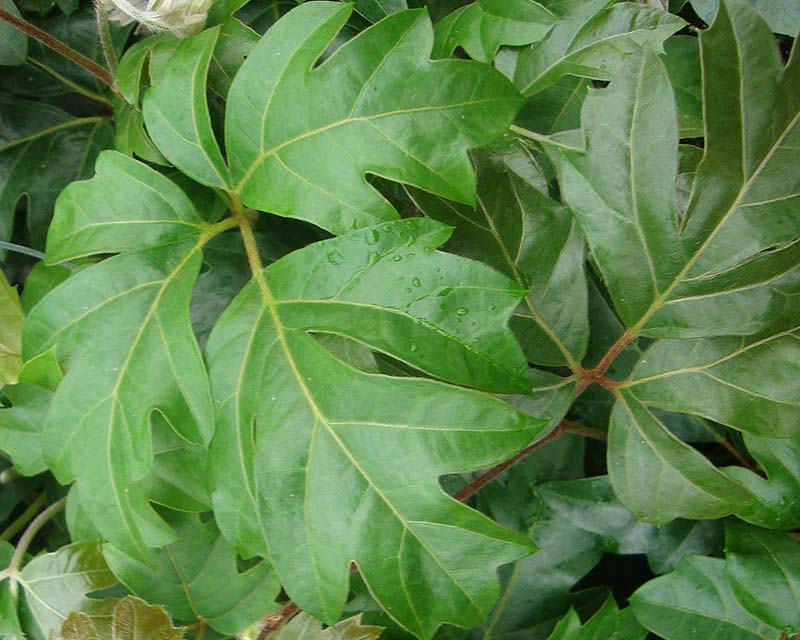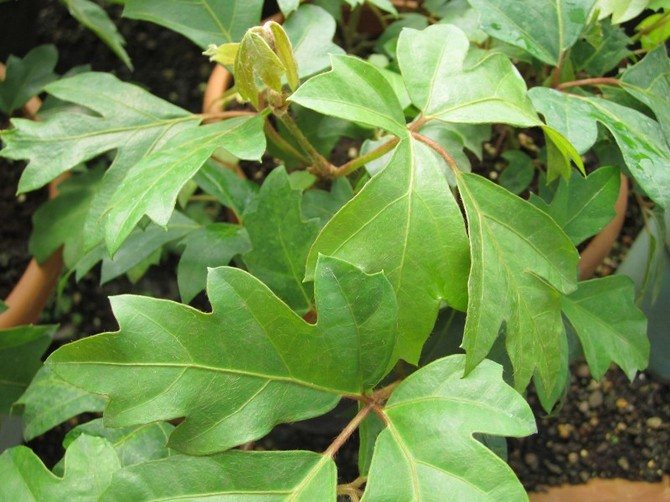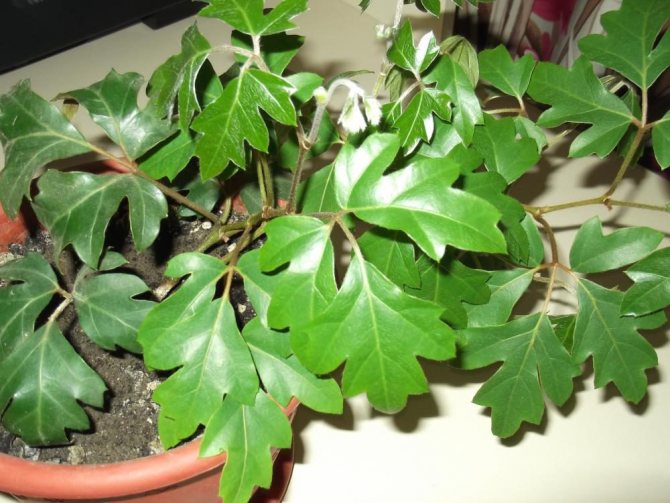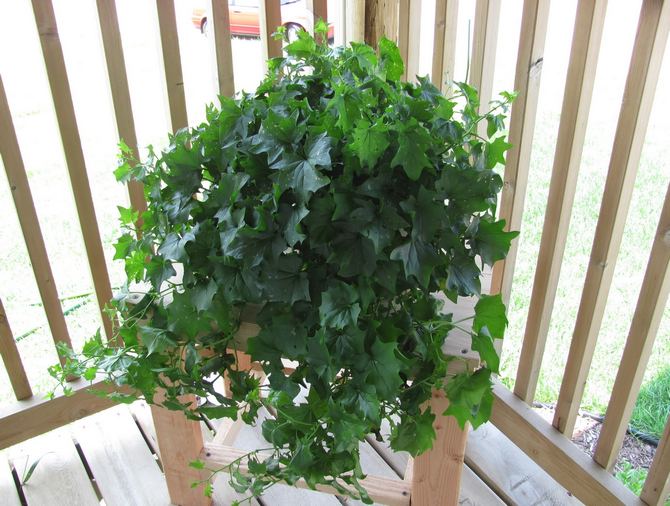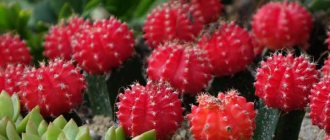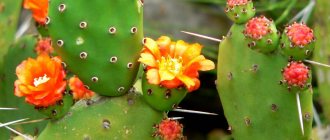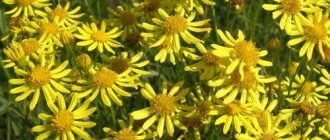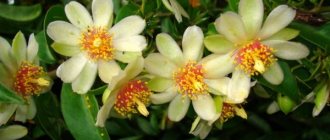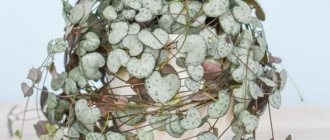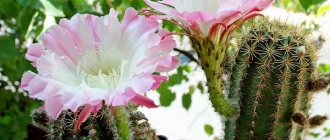Cissus is a kangaroo vineyard native to Australia. It belongs to the most popular indoor climbing crops due to its unpretentious care and pleasant appearance. Long stems organize dense foliage that can curl around a rack or come down attractively from a pot. So, cissus as an indoor flower is ideal for decorating loggias or office spaces.
It is a perennial deciduous, sometimes evergreen climbing plant. Unlike ivy, it winds around the support with the help of special "tendrils", and not the stem itself. It grows fast, is unassuming and is sold everywhere. Elastic shoots grow in 2-3 years up to 3 m in length.
Over time, the stem stiffens, becomes not so elastic, overgrown with a coarse gray bark. Cissus leaves are whole, palmate-complex or lobed, depending on the species. At home, the plant does not bloom, but if buds appear, then these are greenish buds collected in bunches. If pollinated, roundish red or black fruits will develop.
Culture care
As mentioned earlier, cissus does not require much maintenance. However, for faster and more active growth, the plant needs certain conditions. In addition, proper care and well-chosen living conditions will provide the plant with protection from pests and prevention of various diseases. Cissus cultivation must meet a number of requirements and include several important activities:
- Temperature regime... Vines are native to hot southern countries, so the plant is very thermophilic. For normal growth, he needs high temperature indicators: in spring and summer - from 18 to 25 degrees, in autumn and winter - 17-19 degrees. Indicators below 10 degrees are categorically unacceptable, it is also necessary to protect the vine from sudden changes in temperature and drafts. Failure to comply with these conditions will result in the plant losing its foliage.
- Humidity... A high indicator of air humidity is an important condition for the normal growth and development of cissus. In winter, the bush must be sprayed (this can be done with a spray gun) twice a day, and in the summer - once a day. A small bush can be gently rinsed with a warm shower. It is recommended to regularly wipe the foliage of large specimens with a damp cloth.
- Illumination... Active growth of vines occurs in bright sunlight diffused light. The specific requirements for this condition differ depending on the type of plant. For example, rhomboid cissus feels comfortable in the presence of bright light, while Antarctic cissus tolerates shaded rooms (this can be a bathroom, hall, etc.).
- Watering... Dense foliage, many shoots, rapid growth require regular abundant watering. At the same time, moisture stagnation in the root system of the flower should not be allowed. The soil in the pot should be moderately moist. You can understand that the plant needs watering by the state of the top layer of the soil - it dries up, but does not crack (cracks indicate a serious lack of moisture, which is better never to bring). Starting in mid-October, the frequency of watering should be reduced.
- Fertilizer... Complex mineral dressings are recommended to be done once a week during the entire growing season at any time of the year, except for winter (at this time, the culture does not need intensive nutrition).If a dormant period has not been organized during the cold season, fertilization continues to be applied once every two weeks. In this case, the mixture for feeding should be the least concentrated.
- Pruning... The event is held in the spring. The procedure consists in shortening old shoots that have lost their decorative value. It is recommended to pinch young stems - this contributes to their more active growth and branching.
- Transfer... The culture is transplanted into new pots by the transshipment method (that is, with the preservation of an earthen coma). Young plants are replanted in the same way every year. When the culture reaches the age of five years, transplants are reduced to once every 2-3 years. Before each event, a drainage layer is laid on the bottom of the pot, consisting of sand, peat, humus and soil, taken in equal amounts.
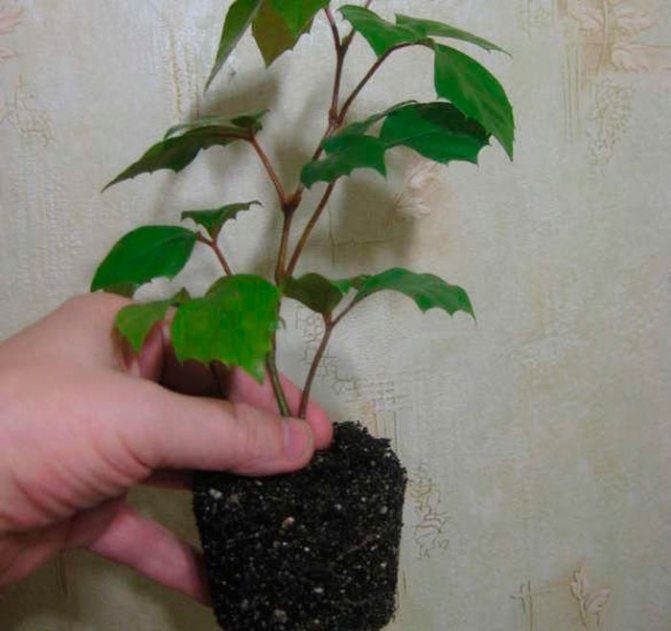
Transfer by transshipment method
How to water and transplant a cissus houseplant
In the spring-autumn period, all indoor grapes are actively growing, so it is important to maintain constant soil moisture. This is needed, first of all, for plants with a large mass of foliage, since their water evaporates faster. In winter, you can only water the Mandianu variety and those species and varieties that do not go into hibernation in winter. At home, caring for cissus should be like this: the hotter, the more often you water. The soil needs to dry out 2-3 cm between irrigation periods. However, you cannot fill the flower, otherwise the roots will rot. If you feed the flower with water too rarely, it will dry out.
In winter and autumn, it is necessary to reduce watering to a minimum - only to maintain the life support of the roots.
Plants up to five years old need to be transplanted annually, then every 2-3 years. This is due to the fact that the flower grows very quickly, and in order for it to continue to develop, it is necessary to change the pot to another - larger one. A ceramic or earthenware container is best. It should be a "breathing" pot, that is, letting in fresh air.
The soil can be taken different, with neutral or underestimated acidity. Some varieties of cissus, such as the Antarctic species, do well in hydroponics. A mixture of sod and leafy soil with an admixture of humus, peat and sand is often used. All parts are mixed in equal proportions.
The transplant is carried out in early spring, when the plant has not yet completely recovered from dormancy. Drainage is placed at the bottom of the pot, then soil and a flower is planted. You don't need to fertilize. At the same time, it is best to trim the cissus to shape it.
Reproduction of cissus
Thanks to the rapid growth, the reproduction of the culture is not a problem. There are several ways to increase the population of creepers:
- Growing from seeds... This is how arctic cissus is most often propagated. Disembarkation is carried out in the spring. For this, a small container is prepared in advance and filled with peat and sand. Then the substrate is moistened and seeds are laid out on its surface. Next, spread a thin layer of soil on top and cover the container with film or glass. The room where the seed box is located is regularly ventilated. Seedlings, on which two fully formed leaf plates have appeared, are transplanted into separate pots. Further transplants are carried out as the "young" grows.
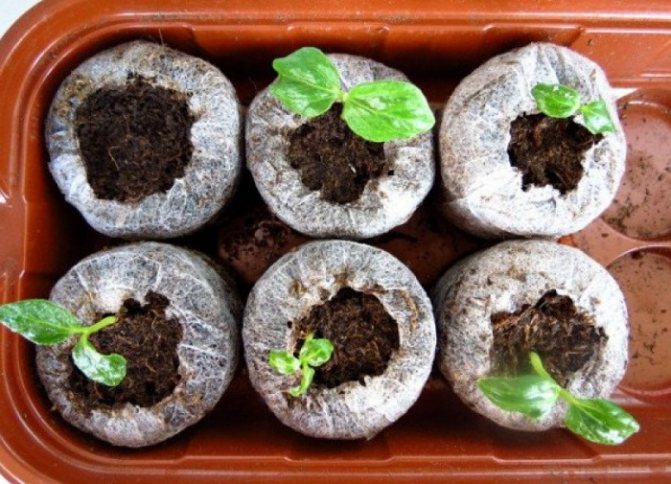

Cissus sprouts from seeds
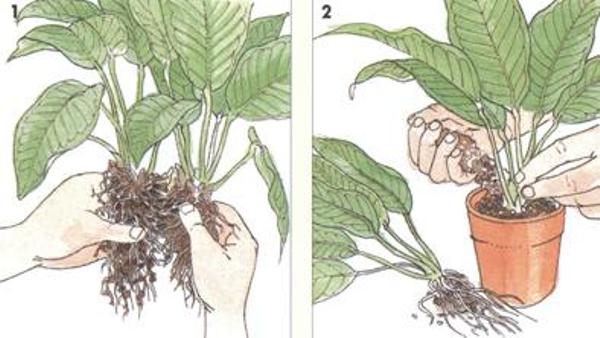

Cissus photo
Diseases and pests
Cissus is resistant to diseases and the effects of various pests and parasites. Nevertheless, it is not always possible to avoid such problems. Among the insects that pose a threat to the plant are:
- mealybug (an insect with a rounded white body, covered with a shell with a whitish bloom);
- scale insect (the body of the insect is covered with a brownish shell).
A small number of pests can be removed manually by removing insects from the vines and rinsing the plant.You can also use various infusions - from garlic, tobacco, orange. Large populations of pests can only be dealt with with modern insecticides.
Cissus diseases are almost always associated with improper crop care:
- If black spots appear on the surface of the foliage and the leaves begin to fall off, then the reason is most likely an excess of moisture in the soil. The solution to the problem is a significant reduction in watering (so that the topsoil dries out by 2-3 cm). If this does not help, you should check the roots. If rot is present, remove the affected parts and move the vine to another pot with a new substrate.
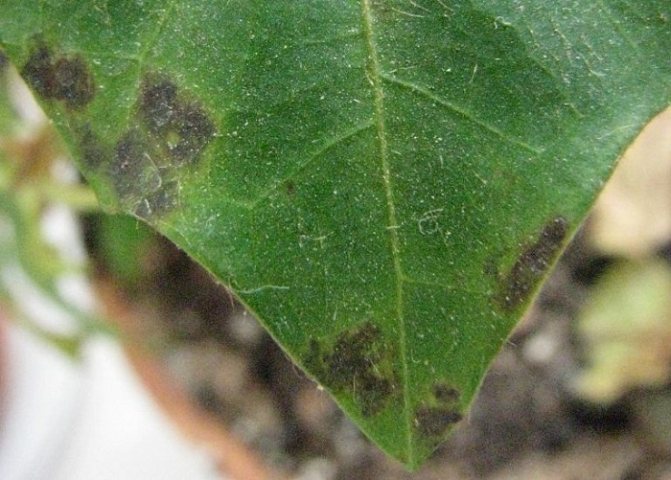

Black spots on the leaves
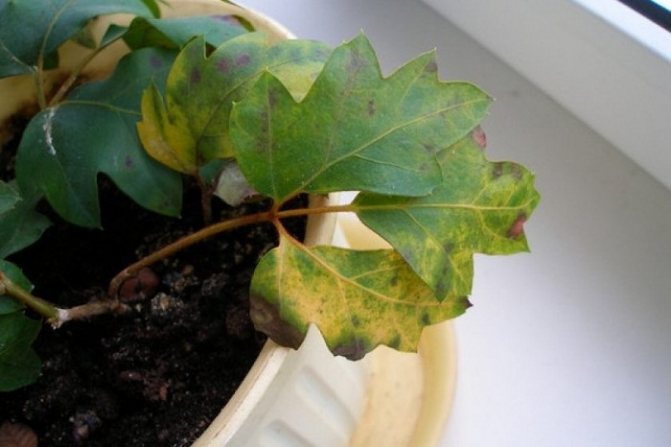

Dried yellow foliage
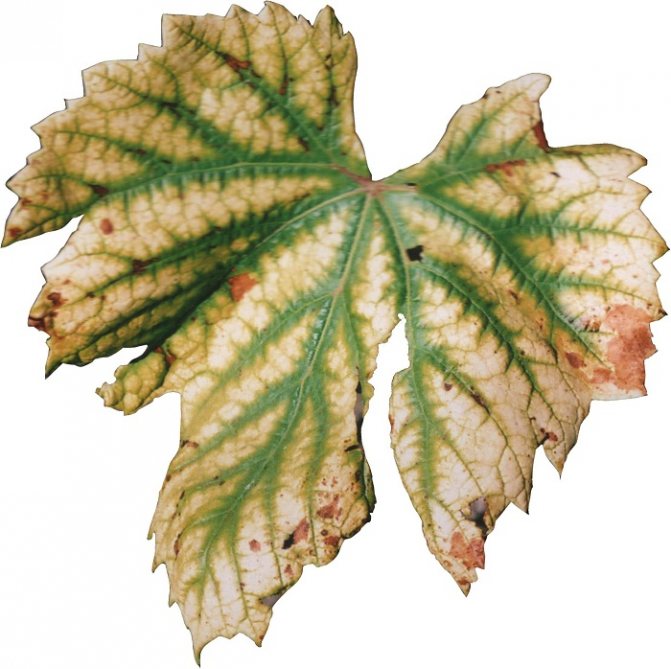

Diseases
Cissus is a plant that is very resistant to various diseases. It can only be affected by root rot, but this is due to improper irrigation and poor soil composition.
The watering schedule of the plant should be observed, it should be planted in loose fertile soil. Through the drainage holes in the pot, excess water should go into the sump.
Pests very rarely attack cissus. Sometimes a spider mite settles on it, but this insect does not multiply on indoor grapes in large numbers.
Nevertheless, having found a tick, you need to treat the plant with insecticides so that it does not begin to lose leaves due to the parasitism of the pest on it.
Cissus - home care, photo species
Cissus (Latin Cissus) is a genus of perennial plants of the family Vitaceae. The tropics are considered its homeland.
Cissus got its name from the Greek word "kissos", which means "ivy". Most of the species are lianas. This means they are fast growing: 60-100 cm per year. Used for vertical gardening, because an adult plant reaches a length of 3 m or more.
Members of the genus differ in appearance and growing conditions. However, those that are used as room culture are unpretentious. Cissus flowers are small, collected in inflorescences at the base of the leaves. They are yellow or green in color. In indoor conditions, the plant rarely blooms.
How to propagate cissus by dividing a bush
There is another way how to simply propagate cissus - dividing the bush. The large flower gives rise to roots that are used as the starting material for breeding cissus. It is necessary to cut the rhizome into several parts and immediately plant it in the ground. Keep, as before, in a warm, closed room with a high level of humidity. The shoots will sprout within three weeks.
Important! Use a clean knife to detach the stems and do minimal damage to the flower's root system.
This method is not often used, as cuttings give excellent results.
Cissus care at home. In detail
Despite the fact that the plant is considered unpretentious, certain requirements must be met for successful home care of cissus.
Bloom
The cissus flower practically does not release at home. The plant is appreciated for its fast growth, beautiful color and rich foliage.
Grown as an ornamental deciduous.
Temperature regime
Different types and varieties of cissus differ in their requirements for the optimum temperature. However, the general conditions correspond to room maintenance.
Bearing in mind the tropical origin of the plant, for most varieties in the summer you need to maintain a temperature of 21-25 ° C. Excessive heat should not be allowed.
In winter, homemade cissus is kept at a temperature not lower than + 8-12 o C. The main enemies of the plant during this period are dry air, overflows and drafts.
Important! For thermophilic multicolored cissus, the temperature in winter should not fall below +16 o C.
Spraying
Since cissus is a tropical plant, it needs to create high humidity. It is achieved by regular spraying over the entire leaf area and around the plant. Typically, spraying is carried out every week, more often in the summer heat.
They are guided by the weather and the state of the plant. The multicolored cissus species needs daily spraying to maintain a constantly moist atmosphere around the leaves.
Advice! Cissus is very fond of warm showers. Bathing can be done both in winter and summer. During the procedure, you need to ensure that the soil is not waterlogged (close the pot with plastic).
Lighting
The choice of a place in an apartment depends on the variety and type of plant. So, rhomboid cissus (c. Rhombfolia) is extremely unpretentious and grows both in the sun and in partial shade. Withstands even the worst lighting conditions. Antarctic cissus (c. Antarcrica) is more demanding and needs diffused light, but feels comfortable in partial shade. A bright diffused light is obtained if you move the plant pot 1.5 m away from the sun window.
The most delicate and light-sensitive is the multi-colored look. It must be placed strictly in partial shade, protected from direct sunlight. Ideal placement - west and east windows or 1.5-2 m from the sunny south window.
Watering
All varieties and species have many leaves that constantly evaporate moisture. This means that at home, cissus needs constant watering. Not only in summer, but also in winter, when the plant suffers from dry room air.
In spring and summer, during the period of rapid growth, they are often watered, as the soil dries out. In hot weather, watering can be daily. In winter, they are guided by the condition of the soil. During this period, watering is reduced to 1 time in 2-3 weeks.
In winter, you need to especially carefully monitor the quality of watering. In cold weather, the soil dries out more slowly, and overflow can cause serious root rot, up to the death of the plant. In this case, the seedling can only be saved by transplanting it into a new dry soil with the introduction of fungicides.
Cissus pot
As with other indoor plants, the pot is selected for the volume of the root system. The walls of the pot should be 1.5-2 cm away from the earthen coma. For young seedlings, a container with a diameter of 9 cm is sufficient. With each transplant, a larger pot is taken. An adult plant is grown in containers with a diameter of about 30 cm.
Advice! In the pot, it is imperative to provide a drainage hole for excess moisture to escape.
Since cissus are climbing vines, it is necessary to think in advance how they will be grown. For ampelous forms, pots are chosen on high pedestals or in hanging pots. For vertical gardening, a system of additional supports, screens of gratings will be required.
Soil for cissus
No special soil is needed for successful cultivation. A generic one from the store will do. You can also prepare the soil yourself. To do this, you need to take leaf and sod land, sand, peat and garden soil in a ratio of 2: 1: 0.5: 1: 1. The main condition is that the resulting substrate must be air and water permeable. To improve these qualities, vermiculite or perlite is added to the ground.
Top dressing and fertilization
Due to its active growth and large leaf mass, cissus needs regular feeding. Universal liquid fertilizer for ornamental deciduous plants is applied along with irrigation. The dosage and frequency depends on the recommendations of the fertilizer manufacturer.
The standard tip is 1 dressing every 2-3 weeks. In winter, fertilizers are not applied.
The first months after transplanting into a new land, fertilization is not needed for the plant. The nutrients available in the soil are enough for him.
Cissus transplant
All the necessary transplants are carried out by the transshipment method: the plant is carefully removed from the old pot together with an earthen lump and, without shaking it off, is placed in a new container. The voids formed at the walls are filled with soil.
The frequency of transplants depends on the age and growth rate of the cissus. A young seedling needs a new larger pot every six months. At the age of 3 years and older, cissus is grown in one pot for 3-4 years or more. With regular top dressing, in this case, it is enough to simply replace the topsoil annually.
Pruning
Spring pruning and pinching of shoots causes additional branching. This operation is performed to form a beautiful dense crown. In addition to decorative pruning, it also has a sanitary function: all wilted, diseased or pest-affected shoots are immediately removed.
Dormant period
In a greenhouse the plant is not deciduous and does not have a pronounced dormant period... When kept indoors, multicolored cissus can shed leaves for the winter and grow new ones in spring. When keeping, it is necessary to observe the temperature regime recommended for each season.
Growing cissus from seeds
In this way, Antarctic and quadrangular cissus (c. Quadrangularis) are grown.
- Seeds are sown in spring in a loose substrate (peat, sand).
- The soil is moistened.
- Crops are covered with a transparent lid or glass and left in a warm room at a temperature of + 21-25 o C.
- The container is periodically ventilated, the soil is kept moist.
- Seedlings appear unevenly within 1-4 weeks.
- At the stage of 2 true leaves, they are dived into separate pots with a diameter of 5-7 cm.
Why do the tips of the leaves dry on the indoor cissus flower?
Light-loving plant. He needs a bright diffused light, for example, for a diamond-shaped flower. The Antarctic species, on the other hand, requires partial shade. Office spaces or hallways work well. However, it is worth protecting the plants from direct sunlight, especially in the fresh air in summer.
All types of cissus can be used as ampelous plants, for landscaping vertical walls dividing rooms, or trellises. The exception is multicolored cissus. This species thrives best in a tropical window as an epiphyte.
It is necessary to maintain room temperature, Cissus discolor and Cissus amazonica prefer at least +18 ° C, Cissus antarctica and Cissus striata tolerate temperatures below +12 ° C in winter. In the summer, you can take it out to the loggia, the main thing is to prevent a draft. Cissus is still a houseplant, so when it gets colder, it is necessary to bring indoor grapes back into the house so that the leaves do not fall off.
It is necessary to provide a high level of air humidity only for the Cissus discolor so that the crown grows. This can be done with regular spraying or warm showers in the summer. That is, you can put the plant in the bathroom and gently walk along the stems with the pressure of water with a temperature of + 30 ... + 35 ° С.
A similar procedure should also be carried out with plants that have a dense crown. Otherwise, cissus leaves gradually dry out or take on a strange shape - convex or concave. The excess liquid must then be poured out of the pan.
Another reason why cissus leaf tips dry out is often dry air. You need to spray the plant with a spray bottle and repeat the procedure regularly in the summer.
Reproduction of cissus
Cissus reproduces successfully not only by seeds, but also vegetatively: by dividing a bush or cuttings.
Propagation of cissus by cuttings
From an adult plant, apical cuttings 5-10 cm long with a bud and 2 leaves are cut.
The stalk is placed in warm water or loose substrate (peat, sand). Roots appear in 1-2 weeks.
Covering the container with cuttings with plastic wrap to create a greenhouse effect can speed up root formation.
As soon as the roots have appeared, the cuttings are planted in the ground.
Reproduction by dividing the bush
The operation is performed during transplantation. An adult plant is divided at the age of 3-4 years.The earthen lump is divided into 2-3 parts so that each part of the plant has a piece of rhizome and independent shoots.
The soil
Indoor grapes are not picky about the composition of the soil. It grows equally well in both alkaline and acidified soils.
Cissus can be planted in regular soil brought from the garden.
It is desirable that sand or other baking powder is present in the soil.so that the water does not stagnate in the pot after abundant watering.
For cissus, you can buy ready-made soil. It is better to purchase a universal earthy mixture for deciduous plants. To mix the soil yourself, you need to take humus, sod land, leafy soil, sand and peat in equal parts.
Diseases and pests
The main difficulties in growing cissus and their possible causes:
- Mold on the leaves - poor drainage. It is necessary to remove all affected leaves, treat the plant with fungicides and transplant it into a new pot.
- Cissus leaf tips dry - dry air. It is necessary to spray more often.
- Cissus grows slowly - lack of light and nutrients. Feeding with liquid fertilizer is required.
- Pale leaves on cissus - "starvation" (the plant needs to be fed) or too strong light.
- Cissus leaves fall - low room temperature. If the leaves wilt and fall off, it could be caused by strong sunlight or a lack of moisture.
- Brown "paper" spots on the leaves - dry air. If spots appear on the lower leaves, this indicates a lack of moisture. Also, spots and rot can appear from waterlogging of the soil.
- Cissus leaves curl - a signal that the plant lacks moisture.
- Leaves bend - there is dry air in the room, it is necessary to increase the spraying.
- Loss of color in leaves - lack of nutrients, you need to apply fertilizers.
- Shrinkage of the lower leaves - insufficient watering.
- Exposing the lower part of the plant stem may be caused by a lack or vice versa an excess of light.
Of the pests, cissus in room culture are affected by spider mites, aphids, and scale insects.
Top dressing so that cissus does not develop brown spots on the leaves
The flower needs nutrients for development. This need is especially evident during the growth period - in spring and summer. Top dressing should start in mid-spring. In the summer - every 2 weeks, from mid-autumn to the end of winter - every 6 weeks. You can take mineral complexes for decorative medicinal plants.
If brown spots appear on the leaves of cissus, it means that it lacks nitrogen. It is necessary to use fertilizers with a high concentration of this substance. Usually they are added to boiled non-hard water, which must be allowed to stand for some time before that, and then the plant is watered.
If brown spots on cissus leaves are accompanied by tarnishing and lethargy of the leaves, then the cissus lacks fertilizer. This can be eliminated by changing the brand of nutrients or increasing the feeding.
When the leaves are suddenly very pale, you need to reduce the amount of light and remove the plant in partial shade.
Types of cissus home with photos and names
Cissus rhomboid, "birch" (c. Rhombifolia)
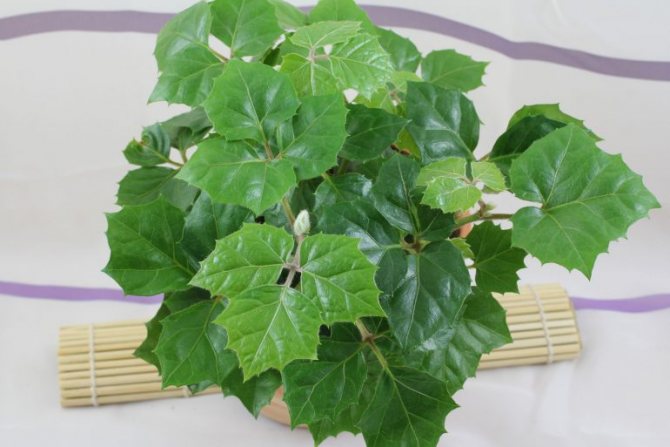

Each leaf consists of 3 leaves. The foliage color of a young plant is silvery, of an adult it is dark green glossy. On the shoots, fluffy brown pile.
Cissus antarctic, "indoor grapes" (c. Antarctica)
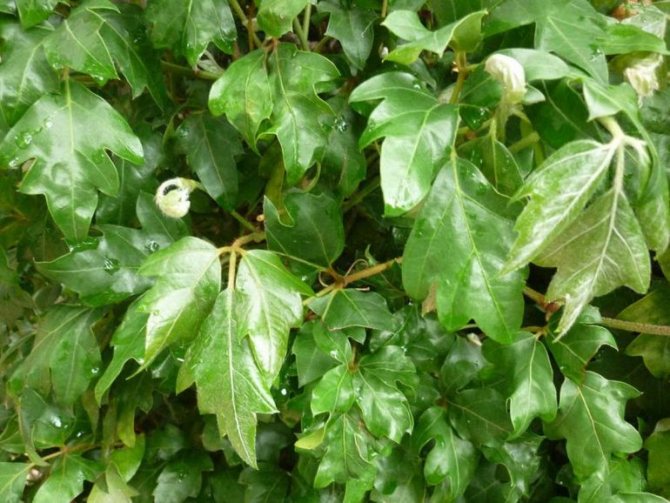

Herbaceous liana, reaches a length of 2.5 m. Leaves are ovoid, green leathery, up to 10-12 cm long. The surface of the leaf plate is shiny. Brown pubescence on the stem.
Cissus multicolored (c. Discolor)
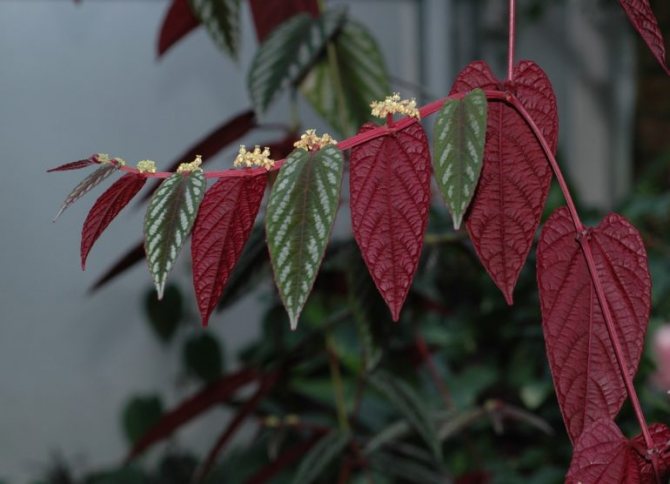

Oblong leaves with silvery and light purple spots up to 15 cm long. The underside is red.
Cissus round-leaved (c. Rotundifolia)
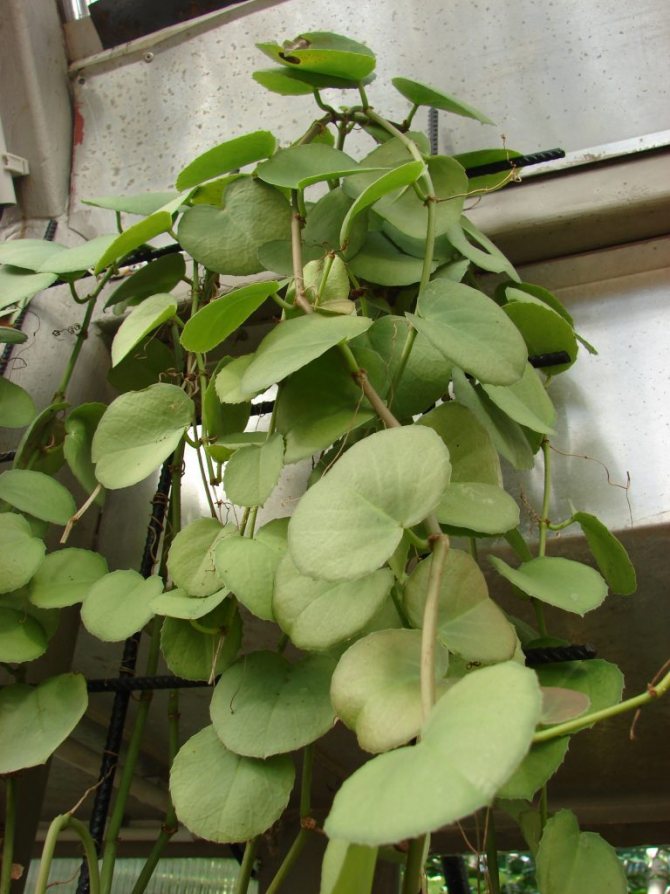

Vine stems are tough. The leaves are rounded with jagged edges. The color of the leaves is green-gray. There is a waxy coating on the surface.
Cissus glandular (c. Adenopoda)
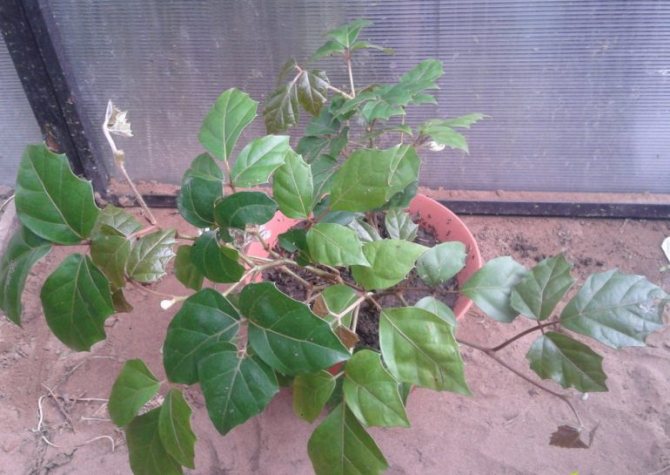

Fast growing vine. Olive-tinted leaves, pubescent. On the reverse side - burgundy. Each leaf consists of 3 leaves.
Trim / Support / Garter
Indoor grapes must be pruned annually. This procedure stimulates the emergence of many new side shoots. The plant is pruned in mid-April before active growth begins.
When cissus shoots are located on a vertical surface (on the wall) trimming the tips of the shoots. Usually several cuttings are planted in a pot.
After the shoots reach 30-50 cm, they are pinched. This is how 10-12 main lashes are formed. Then they are annually shortened by 10-15 cm so that they form side shoots.
If the plant is grown by the ampel method in a hanging pot, very long lashes do not need to be left. All branches should be no more than 50 cm in length so that the entire bush looks compact and luxuriant.
In such a plant, every year, long shoots are cut in half, the rest - by 1/3, so that they hang beautifully around the pot or pots. Then, after pruning, additional lateral shoots are formed, making the bush more beautiful and lush.
Features of cissus
Cissus is a vine that belongs to the grape family. At home, it is grown as an ampelous plant. The people also call it "home grapes" or "birch". This genus unites about 300 species that can be found in natural conditions. Most of the species in nature grows in areas with subtropical and tropical climates. Cissus grows antennae, with which it clings to the support. The shape of the foliage depends on the variety and can be whole or dissected.
When grown at home on a liana, flowers appear extremely rarely. False inflorescences of an umbrella-shaped form include small faded flowers that are of no decorative value. Liana is appreciated for its beautiful foliage. They grow it in hanging pots. Cissus can be used to decorate both offices and apartments, as well as glazed balconies.
It was noticed by flower growers that if favorable conditions are created for such a vine, then it will delight with very rapid growth. The plant rapidly braids the support, while it grows a large number of lush leafy stems. Liana is often grown in winter gardens.
Humidity
Cissus does not require humidification at room temperature... Only in very intense heat does its leaves begin to dry. At this time, it is useful to humidify the air by spraying.
During cool wintering, high humidity can lead to fungal infections of the plant. If the flower is in a heated room, the air near the plant should be humidified.
The plant is sprayed only in very dry and hot weather. Spraying is not required at room temperature below 25 ° C.
Cissus should be washed monthly under the shower.
Shower washing is done for hygienic reasons. The leaves of the grapes are gathering dust, and it is possible to clean them well of dust only under running water at room temperature.
Cissus care at home
If you decide to grow cissus at home, then you need to take into account that it does not need any special care. However, in order to grow the most effective liana, you need to know in what conditions it is most comfortable to grow. Also, proper care and suitable conditions for growth will be an excellent prevention of various diseases and the appearance of pests.
Temperature regime
Cissus belongs to heat-loving plants, and therefore, for normal growth and development, it requires: in the summer - from 18 to 25 degrees, and in the autumn-winter period - about 18 degrees. Make sure that the room where the vine is located is not colder than 10 degrees, and it also needs to be protected from sudden changes in temperature and drafts, otherwise all the foliage can fly around it.
Illumination
Needs bright sunlight, but it must be diffused. As a rule, each of the varieties has its own lighting requirements. For example, Antarctic cissus can be grown in shaded areas, so it can be grown in a bathroom or in a hallway with poor lighting.At the same time, rhomboid cissus needs a lot of light.
Watering
Since this is a fast-growing plant with many shoots and lush foliage, special attention should be paid to watering. They should be abundant, but do not let the liquid stagnate in the root system. Make sure that the potting medium is slightly damp at all times. The bush is watered immediately after the top layer of the soil mixture dries up. From about mid-autumn, watering should be reduced.
Humidity
It needs high air humidity, so the bush needs to be moistened from a sprayer quite often. In winter, this is done twice a day, and in summer - once a day. If the bush is not very large, then you can arrange a warm shower for it. For voluminous vines growing on a support, you need to wipe the foliage from time to time with a damp cloth.
Fertilizer
Liana responds well to feeding with any complete complex mineral fertilizer. It is added to the substrate every 7 days throughout the growing season. In winter, the plant does not need a lot of nutrients, so it is not necessary to feed it. However, it should be borne in mind that if in the cold season a rest period was not organized for cissus, then it continues to be fed, but already once every 15 days, and at the same time a nutrient mixture of a lower concentration is used.
Transfer
Young bushes are transplanted annually by transferring them into new pots. From the age of five, transplants are carried out less often, namely, once every 2 or 3 years. At the bottom of the pot, do not forget to make a good drainage layer, but fill it with a substrate consisting of sand, good humus, peat, turf and leafy soil, which are taken in equal parts.
Pruning
It is recommended to prune the liana in the spring. For this, the old lashes, which have become less attractive, are shortened. To improve branching, pinching of young shoots is carried out. The plant tolerates pruning well and after it begins to grow actively.
Pruning if cissus leaves fall
Pruning is carried out at any time of the year, and if the lower leaves of the cissus fall off, in the spring it must be cut by ¾. In other cases, the flower is cut in half and the stems that are left without cover are removed. If these are plants that twist up the support, pinching is carried out in order to give splendor and density to the crown. It so happens that in winter, with an insufficient amount of light, cissus lets out powerless stems, which die in spring or give even weaker shoots. In this case, they must be removed in early spring.
- After pruning at home, care for a flower such as cissus should be correct: put the plant in a well-lit place, water, if indoor grapes are transplanted, start feeding in a month.
- If the leaves suddenly began to fall off, there are two reasons: draft and heat. You can change the position by moving the flower to a different location.
However, such symptoms may indicate decay of the root system. Check if you are overflowing with cissus!
If the leaves suddenly began to curl and fall off en masse, this means that there is not enough oxygen in the soil. It is necessary to loosen the soil every 15 days.
When the lower leaves of cissus fall off, do not worry, this is not a problem, but a normal phenomenon for a flower - it grows.
Reproduction methods
Since cissus is fast growing, it is very easy to propagate. There are several ways to do this.
Cuttings
Cuttings are harvested even in summer, even in winter. 3 or 4 cuttings are planted in one container for rooting, while it is filled with a fertile light substrate with a high content of peat and sand. Water them systematically and keep them warm (20 to 22 degrees). If young foliage forms on the handle, this means that roots have grown out.
Dividing the bush
If the adult cissus has grown strongly, then it can be divided during transplantation. It is recommended to shorten the shoots during planting in delenoks, in this case they will take root much faster.
Growing from seeds
The seeds are mainly grown from the arctic cissus. Sowing seeds is carried out in the spring. To do this, take a small box and fill it with a substrate consisting of peat and sand. Moisten the surface and spread the seeds on it. Sprinkle them with a thin layer of soil mixture, cover the container with a film (glass) on top. Crops need regular ventilation. The picking of seedlings into individual pots, reaching 70 mm in diameter, is carried out after the formation of two true leaf plates. In the future, transplants are carried out as the bushes grow.
Care errors
| Problem | Cause | Correction |
| The tips of the leaves dry, the foliage itself bends. | Insufficient humidity, the plant freezes. | Spray the plant often, in winter keep it away from the radiator, stove, fireplace, but in a warm enough place. |
| Leaves become pale, brown, and mold may develop. | Poor drainage or waterlogged soil. | Drain regularly, do not overfill. |
| Leaves lose color, spots appear. | The ivy is on the sunny side. | Rearrange the plant, since direct sunlight is destructive for it. If it stands near the window - around the corner or build a shading canopy for it. Artificial lighting needs to be timed. |
| Leaves are spotted and curled up. | The soil is not moist enough. | Do not allow the soil to dry out, water regularly. |
| Spot at the bottom of the crown. | Severe drying out of the earth. | Increase watering. |
| Unexpected partial loss of leaves. | Excessive draft or hypothermia. | Place the bush in a calm and comfortable environment. |
Possible problems
If cissus is systematically examined and properly looked after, then it will be possible to avoid many problems that may arise when it is grown indoors.
- If the leaves of the plant bend and begin to drymeans the air in the room is very dry. Initially, you need to moisten the space around the vine, and spray the leaves with water.
- Leaves dry and fly around this is due to the high temperature in the room. It is necessary to rearrange the flower in a cool room, and in summer you can take it out into the air.
- If the leaves turn pale or light spots appear on them, this signals too bright lighting, the leaves have a sunburn. The plant should be shaded.
- Cissus has brown spots due to strong waterlogging of the soil. It is necessary to stop watering so that the top layer of the earth dries out by 2-3 cm.
- If Cissus is actively dropping leaves, it must be rearranged from a cold room and protected from drafts. And also create the desired temperature regime for Cissus.
- Leaves wither and fade, the plant slows down its growth. Cissus lacks nutrients. The appearance of black spots indicates a lack of phosphorus, brown spots - nitrogen. It is necessary to choose a fertilizer with a balanced composition and feed the vine in a timely manner.
- Cissus stops growing, young branches do not appear. The plant has taken up the entire space of the pot; transplanting into a larger pot is necessary.
Fertilizer
The cissus houseplant is fed from mid-April to the end of October. Liquid mineral mixtures are suitable for fertilizing the soil. The procedure is carried out every 2 weeks. Fertilizers are diluted with water to the consistency specified in the instructions., and applied to wet soil.
At the end of summer, feeding is gradually reduced. In September and October, the plant is fed once a month. Then the feeding is stopped before the onset of spring.
Since indoor grapes grow very quickly, they actively use nutrients, thereby depleting the soil.If you want the plant to develop quickly, it needs high-quality feeding twice a month. For this purpose, any mineral fertilizers for decorative leafy indoor plants are suitable, for example, "Pokon", "Etisso", "Flower Paradise", "BonaForte".
From time to time, mineral dressings can be alternated with organic ones. The rhomboid cissus especially needs additional nutrients as it builds up a very lush green mass.
Types of cissus with photos and names
In total, there are about 300 species of cissus, but only a few of them are cultivated in indoor conditions by flower growers. Moreover, each of these species has several varieties that differ from each other. They have a very high unpretentiousness and endurance.
Cissus rhombifolia
This species was named so due to the fact that its foliage has a diamond shape. It belongs to fast growing plants. If you take good care of it, then during just one growing season, it can add up to 200 cm in length. Such a vine is distinguished by high endurance, and it also grows well in places with unfavorable conditions.
Cissus discolor
This species is valuable in that it has a variegated, spectacular foliage, while the main color is pale red. On the entire surface of the plate there are specks of a silvery color, while its seamy surface is purple.
Cissus striata, or striped
The foliage has a shape very similar to that of a girl's grape. As a decorative liana, varieties with a pale red color are grown. Differs in endurance, unpretentiousness and rapid growth.
Antarctic cissus (cissus antarctica)
This highly decorative look is more demanding in its care. With poor lighting, a slowdown in the growth of the bush is observed, and it can also suffer from excessively low air humidity. The foliage color is green, monochromatic.
The most decorative of all home-grown cissus is the multicolored cissus. It stands out among other species for its spectacular and unusual color. However, you need to be prepared for the fact that it is not so easy to grow it. In nature, such a plant is found in the tropics. Therefore, in order for the vine to grow and develop rapidly, the air temperature in the room must be at least 25 degrees all the time, and it also needs high humidity. The local inhabitants of the island of Java cut the shoots of the vine and drink its juice.
Temperature
In summer, cissus grows well at an air temperature of 22-27 ° C, which is typical for our latitudes. But it can also withstand heat over 30 ° C.
Do not leave cissus in a draft: cold air will lead to the appearance of dark spots on the leaves.
In winter, the air temperature can be reduced to 16-18 ° C... But if it is not possible to organize a cool winter for the plant, you can keep it at room temperature in winter.
In the cold season, the temperature of the content can be reduced to 10 degrees. This applies to all species, except for cissus bicolor and rhomboid. For these thermophilic species, the winter minimum is 16 degrees. The most cold-resistant is Antarctic cissus - it can withstand temperatures down to 5 degrees.
If possible, in the warm season, indoor grapes can be taken out into the fresh air: on a balcony, loggia or veranda. In this case, it is important that he is not in a cold draft.
How to plant and transplant a plant
For planting cissus, pots made of any material are suitable, but ceramic pots are more resistant and allow the roots of the plant to breathe. The size of the pot should not be much larger than the previous one. It is important to select a volume at which the root system can slightly increase the root mass. And don't forget about mandatory drainage.
Please note that cissus is a vine that needs support. Ladders, sized plants or decorative driftwood or branches will cope with this task.
Cissus plants look very beautiful in hanging pots. In this case, there is no need for support.
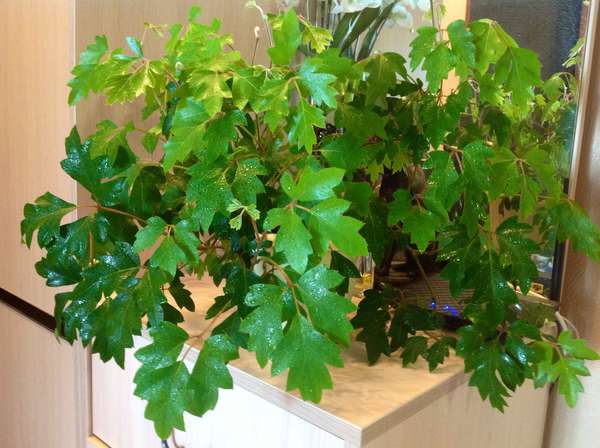

The lush foliage of cissus needs support
The soil for planting cissus should be slightly acidic or neutral and always nutritious. The plant will take root well in a universal soil. But it is best to prepare a mixture with your own hands, which will differ from the store's better air and moisture permeability. To do this, you need a son-in-law in equal parts of humus, turf and leafy soil, peat and half of the coarse sand or perlite.
It is best to transplant in the spring - after a period of rest. Young cissus plants are transplanted annually due to their intensive growth. Adult plants undergo the procedure less often - once every 3-4 years. In large specimens, it is sufficient to replace the top 5–8 cm of soil with fresh soil.
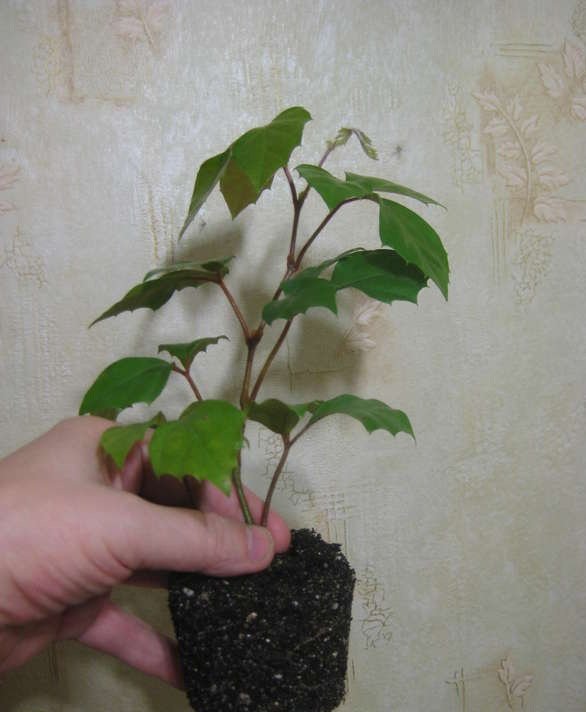

Young Cissus needs an annual transplant
Step-by-step transplant process
- The transplant is carried out by the transshipment method, which injures the roots in the least possible way.
- We lower the plant into a prepared pot, at the bottom of which a 3 cm layer of drainage is laid, earth is poured and a support is fixed.
- We fill the plant with soil mixture. In order for the earth to be evenly distributed between the roots and compacted, we spill periodically with water.
- After transplanting, we move the plant to its usual place.
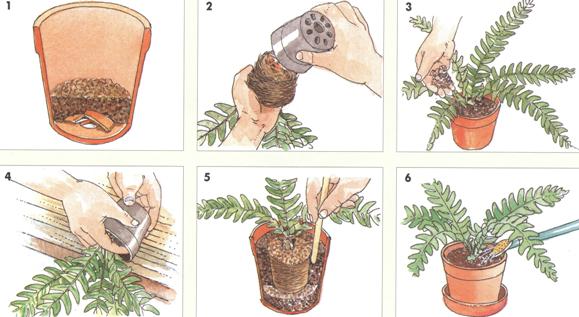

Plant transplant using the transshipment method
general information
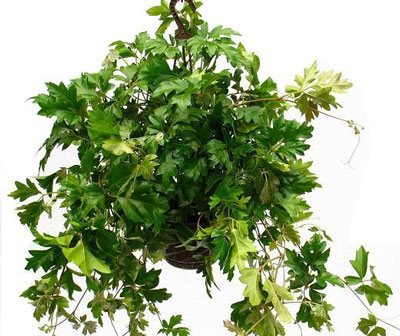

Cissus is one of the representatives of perennial vines.
As it grows, the shoots reach 3.5 m in length.
With age, the base of the plant lignifies, loses its former flexibility and is wrapped in a gray bark, which soon begins to crack and flake off.
The stems have characteristic internodes containing tendrils and petiole leaves. Often, the ends of the antennae form disc-shaped suckers, which are necessary for clinging to adjacent surfaces.
Light green petiole leaves are lobed, palmate-complex, or whole. Attached next. The root system is compact.
Reference! Indoor flowering is very rare, but the plant benefits from beautiful ornamental foliage.
During the flowering period of small sizes, greenish flowers form brushes, if pollination occurs, in the future, black or red fruits containing seeds will appear.
Transplant rules
Young cissus are transplanted every spring; for adult plants, one transplant is enough every 2-3 years. If the vine is overgrown, it is enough to replace the topsoil. The pot is chosen deep, slightly wider than the previous one. A thick drainage layer must be laid out at the bottom.
The soil for cissus is made up of the following components:
- leafy soil;
- peat;
- sod soil;
- sand.
Before use, the new soil is calcined in the oven. The transplant is carried out by the method of transshipment of an earthy coma. The procedure should be combined with pruning.
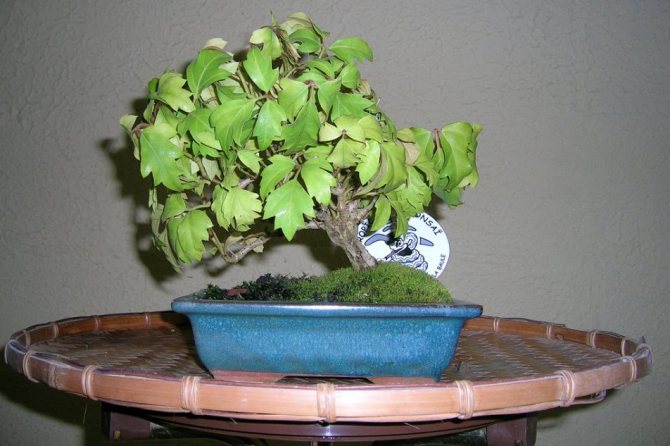

Common types of cissus flowers and their photos
Of the huge number of varieties of indoor grapes, only a few of them are grown at home.
Cissus Antarctic (liana kangaroo)
Antarctica is the most common shade-tolerant species, which is a herbaceous climbing liana that grows up to two and a half meters. The dark green smooth foliage with serrated edges is ovoid, up to twelve centimeters long and up to eight centimeters wide. On the petioles and stems of the Antarctic cissus, as can be seen in the photo, there is a brown pubescence. The inflorescences consist of small greenish flowers.
Cissus rhomboid (grape ivy)
The diamond-shaped cissus is characterized by thin, highly branching stems reaching one and a half meters in length.The leaves consist of three parts, have a diamond shape and a dark green color on the upper surface, and their lower part is reddish. Red-brown hairs are clearly visible on stems, whiskers and petioles. Flowers of green color are collected in cluster inflorescences. The fruit is a red edible berry.
Rhombic cissus, as a rule, is grown on a support (see photo). May be located in a shaded area. Of the varietal varieties among florists, the cissus Helen Danica, also shown in the photo, is very popular.
Cissus multicolored (bicolor, discolored)
A very beautiful view, but requiring more care than others. It is very important for him to maintain the correct temperature regime and sufficient air humidity. Cissus varicoloured is a vine with reddish-purple stems that grow up to two meters in length under good conditions.
He has a delicate thin mustache and velvety, glossy reddish-green leaves with purple veins, spots and a silvery pattern on the upper side, the lower part is dark pink. They have an elongated heart-shaped shape, up to ten centimeters long and five to eight centimeters wide.
Umbrella inflorescences consist of small yellow flowers. A feature of this species is that for the winter it can throw off the foliage. If this happens, you need to prune the stems and reduce watering. With the onset of spring, foliage will reappear.
Cissus quadrangular
Quite an unusual species for cissus, the liana of which is distinguished by thick shoots with four edges and small leathery, three-lobed leaves. The plant can grow up to one and a half meters. Flowers that gather in inflorescences can be white, yellow or green.
Cactus
A rare species, which is a liana, the fleshy and juicy stems of which resemble varieties of cacti. Leaves are absent, whiskers emerge from internodes. Grows very well using hydroponics.
Cissus Jutta
This cissus is a perennial upright succulent. It has thick, pointed-oval leaves of olive color with a reddish tint and a touch of wax. The plant can grow up to two meters in height. The stem is shaped like pins and forks at the top into fleshy branches. With age, the yellow-green bark begins to exfoliate into paper-like ribbons.
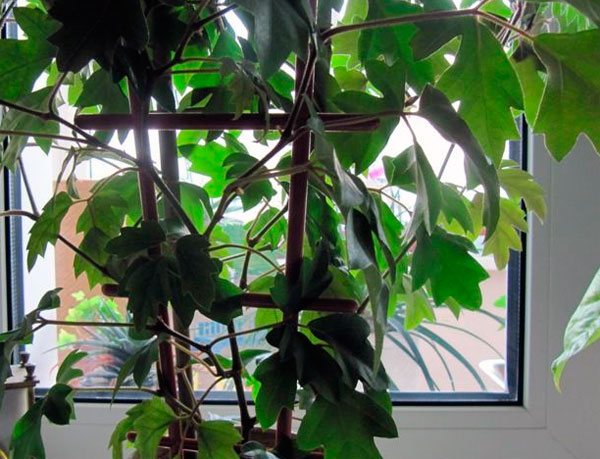

Cissus Bainesa
This species is also a perennial shrub that resembles succulents. Its stem can resemble a ball or bottle, the lower part of which can be up to forty centimeters high and about twenty wide. The top of the plant branches out in the shape of a fork.
Serrated, pubescent, tomentose foliage on short petioles has a trifoliate shape and a bright green color. The color of the bark ranges from light yellow to green. The flowers are yellowish-green in color.
Cissus Tuberose (caudex)
The appearance of this deciduous liana is quite exotic, due to the fact that it has a caudex - a bizarre thickening at the bottom of the trunk. In young plants, it has a green color, and later a thin silvery bark forms on it. It is peeled off and renewed annually.
The internodes of long stems (up to two centimeters in diameter) contain aerial roots. When the vine reaches the soil, they grow into it and form new shoots. The flexible, carved foliage has a five-blade shape and resembles a Canadian maple tree. Its diameter can be up to seven centimeters.
A distinctive feature of cissus tuberose is the presence of a mustache, which serves as a kind of suckers. With their help, the plant can easily climb up the support and any smooth surface, for example, along the wall.
Striped cissus (striata)
The striped cissus is a sturdy, slender, curly perennial that can grow up to ten meters in length.It has reddish shoots and three or five-fingered leaves about five centimeters in diameter. They are ovoid and have a leathery, glossy, bright green surface.
Greenish flowers gather in corymbose inflorescences. The fruits are black berries no more than one centimeter in diameter.
You can get acquainted with the hibiscus or Chinese rose plant and see its photo at this address:
It describes in detail what kind of care the hibiscus flower needs at home.
And from this article you will learn how to propagate hibiscus by cuttings at home.
Is it possible to keep cissus at home, signs and superstitions
Homemade grapes have not a very good reputation among superstitious people and are traditionally surrounded by signs, like many vines. He is credited with mystical properties in the field of human relations. It is believed that grape ivy "survives" from the home of the males. Such plants are called "muzhegons", and besides cissus, this group includes tradescantia, hoyu, scindapsus.
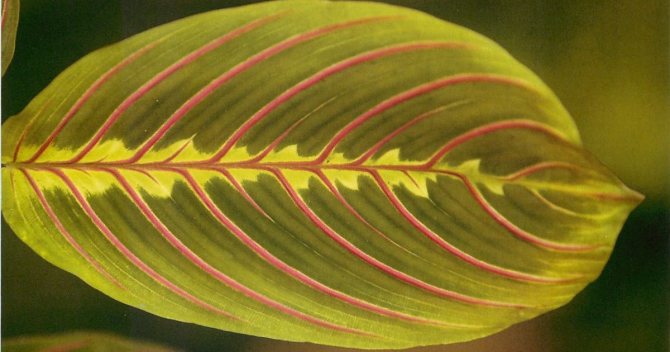

You may be interested in:
Arrowroot - home care, signs and superstitions, types and reproduction Arrowroot has gained particular popularity in floriculture - a flowering plant that surprises with its decorativeness as if ... Read more ...
For people devoid of superstition, cissus is a beautiful ornamental plant that has a number of useful qualities. Cissus tends not only to humidify the air. It cleanses it by absorbing dust and harmful vapors, which means it minimizes headaches. Formaldehydes, which are part of some building materials, can provoke nausea and dizziness, and house birch clears the air of their presence.
The plant has a strong antibacterial effect. Phytoncides actively suppress bacterial infections and some allergens, are effective against intestinal infections. Cissus is used to reduce fatigue and increase immunity. Certain types of flower are used as an anabolic, with their help they treat sprains and even fractures.
Homemade grapes are recommended for those who suffer from exhaustion and fatigue.
Cissus pests
Most often, a scabbard, spider mite and aphids attack a room birch:
- Aphid... A dangerous sucking parasite that colonizes and feeds on plant sap, bringing it to death. You can get rid of them by spraying the affected flower with infusions of garlic, marigolds, celandine, potato tops. From chemical insecticides Intavir, Fitoverm, Preparation - 30, Kinmiks, Aktara help.
- Spider mite... Very small, hardly visible to the naked eye. Its presence is determined by the cobwebs that braid the leaf blades of the plant. He does not like moisture, so frequent spraying of the flower can help in the fight against it. Sulfuric and phosphorus agents, onion and garlic infusions, Aldicarb and Karbofos preparations also help.
- Shield... Tiny insects that resemble flat ovals with hard shells that adhere tightly to cuttings, leaves or stems. Having found this parasite on the plant, you need to treat it with an insecticide such as Aktara or Aktellik.
Indoor care and cultivation
In order for a flower to delight you with lush and bright greenery, it is necessary to create suitable conditions for it. Cissus feels great both in winter gardens, botanical gardens, greenhouses, public premises and in the room.
Creation of favorable conditions
Humidity
Cissus quickly picks up moisture due to the large amount of foliage, so the flower loves frequent abundant watering, especially during the period of rapid growth.
The air humidity may be low, but in order for Cissus to gain green mass faster, it must be sprayed regularly.
The water for spraying should be settled or boiled so that no streaks remain on the leaves.In the summer season and during the heating season, it is good to arrange a warm shower, washing the leaves from dust. In the winter season, the plant should be watered sparingly, draining the water from the pan.
Priming
For planting, you can use universal soil from the store, or start cooking yourself. The main composition is sod and leafy soil, fine sea sand, humus and peat are added to the mixture, the soil should be neutral.
Flowers are transplanted after the winter period, in the spring, before the start of active flowering. It is advisable to replant a young plant annually, an adult Cissus needs a transplant much less often. With each transplant, the size of the pot must be increased, it is advisable to choose a ceramic one, so the roots will breathe.


Drainage is initially placed on the bottom of the pot, then a mixture of peat and sand, leafy earth and sod soil, in equal parts. The Cissus transplant is carried out carefully, without touching the root system using transshipment.
Cissus is distinguished by its rapid growth, it actively requires vitamins and mineral fertilizers, it is advisable to feed it twice a month, in the spring-summer period. For Cissus, top dressing for ornamental plants, and mineral, organic fertilizers are suitable.
Light and temperature
The plant likes bright sunlight, but can grow in the shady side and under artificial light. But in a bright room, the greens of Cissus become richer and thicker.
For comfortable growth, it must be remembered that in summer there should be as much light as possible. It is undesirable for the plant to be in direct sunlight, it is better to shade Cissus a little.
Drafts and sudden changes in temperature can damage the plant, so it should be protected from these unwanted factors. With hypothermia, Cissus can shed its leaves.
Pruning
You can prune a plant in several cases:
- For active growth of shoots and the best branching, shoots must be pinched periodically;
- If the branches have grown and become bare, they need to be cut off;
- In spring, the vines are cut in half to help stimulate the Cissus to thick, young foliage.
Reproduction
How to propagate Cissus, you can do it in several ways. It is not recommended to touch the plant in winter. Rooting can be done both in water and in soil.
By dividing the bush
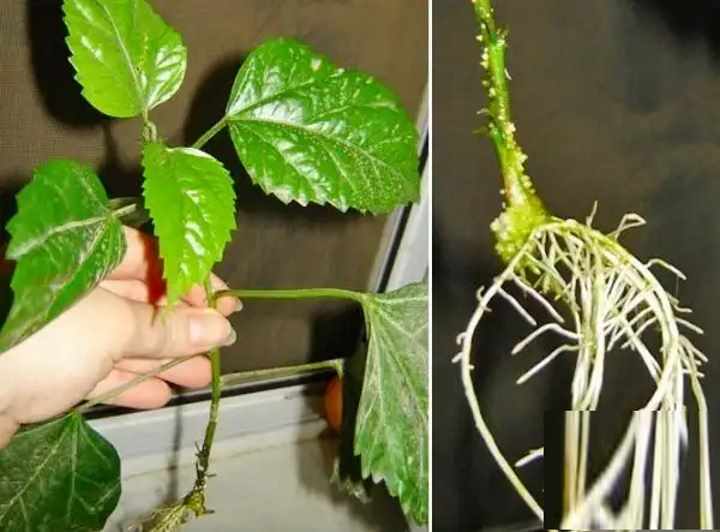

Reproduction by splitting the roots is best done in the spring during transplantation.- Adult Cissus grows and forms root processes by itself, during transplantation it can be divided.
- The rhizome is cut into several pieces and planted in a pot.
- The adaptation process takes place quite quickly, after which the plant actively starts growing.
Using seeds
By seeds, Cissus propagates in the following way:
- First, we prepare a container, on the bottom of which we pour a mixture of peat and fine sand;
- We spread the seeds on the surface, slightly pressing down;
- Then we water the ground and cover with foil;
- We keep the seedlings in a bright and warm place, watering regularly;
- The first shoots may appear in six months, when the plant gets stronger, several leaves will grow on it, it can be transplanted.
The best seedlings are obtained from the seeds of the Arctic Cissus.
Cuttings
Cissus cuttings are prepared in spring or summer by choosing strong, well-developed shoots with young buds.
At first, several cuttings can be placed in one container, when they begin to actively germinate, they must be transplanted into separate pots. Thanks to this type of reproduction, you can get a lush bush. Root cuttings in a small greenhouse.
1. Seven Secrets of Success:
| 1. Growing temperature: summer - 20 - 25 ° С, in winter some varieties of cissus require a cool dormant period, while other plants are grown throughout the year at room temperature. |
| 2. Lighting: green-leaved plants are easy to tolerate partial shade variegated plants will need enough bright light. |
| 3. Watering and humidity: dry the substrate between waterings 2 - 3 centimeters deep between waterings during the growing season, in winter, reduce the frequency of watering in accordance with the temperature in the room. Watering frequency will also depend on the specific cissus species. The air humidity is quite high. |
| 4. Pruning: formative pruning to create a lush crown, sanitary to remove old and weak shoots. |
| 5. Priming: well drained, high in organic matter and easily permeable to moisture and allowing the root system to breathe, with a neutral or slightly acidic pH. |
| 6. Top dressing: mineral fertilizers for flowering plants in spring and summer every 2 weeks. In autumn, feeding is reduced, in winter it is not carried out at all. If the plant is in a warm place. then feeding can be done once a month, even during the winter months. |
| 7. Reproduction: by division during transplantation, vegetatively - by cuttings, air layers, sometimes a flower is grown from seeds. |
Botanical name: Cissus.
Cissus flower - family... Grape.
Homeland of the plant... South America.
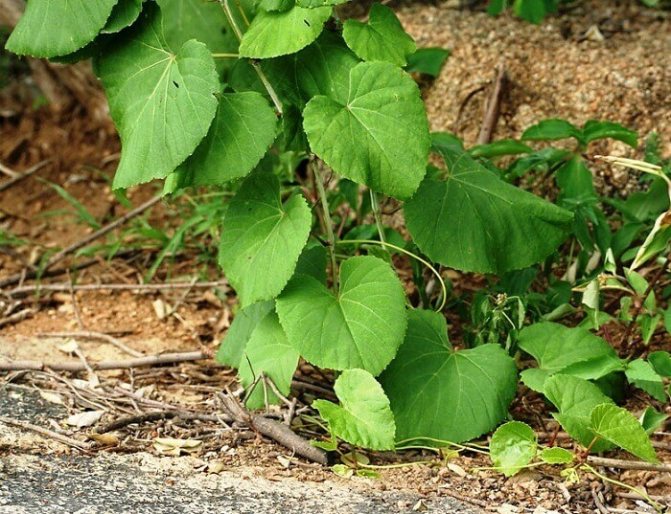

Description... Cissus, indoor grape or indoor birch is a very extensive and varied genus of lianas and shrubs.
Stems creeping, drooping, branched, woody in the base with age and covered with brown bark.
Different types of cissus also differ from each other in size, shape and color. leaves... Some plants have simple, lanceolate or cordate leaves, while others have finger-like - dissected or compound leaves - consisting of several oblong or rounded segments with jagged edges.
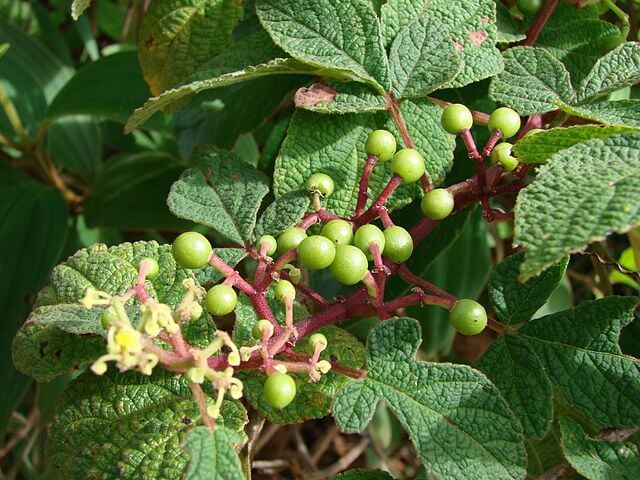

The leaves of most plants are green, glossy, variegated varieties are distinguished by the presence of contrasting white spots on the leaf plates.
Vines climb the support clinging to it antennae... Some plants have long aerial roots.
The flowering of cissus is of no interest - small branched brushes bear small greenish or pink flowers.
If the flowers are pollinated, the plant will form clusters of rounded black or reddish berries.
↑ Up,
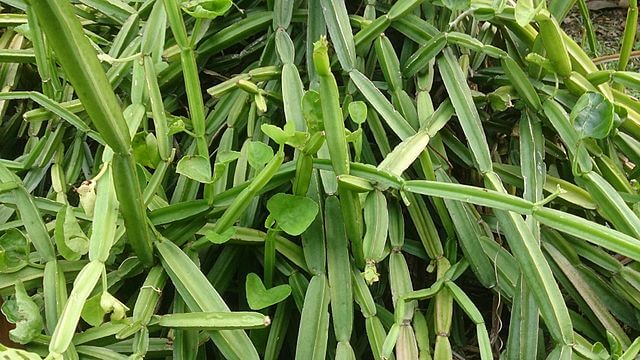

Height... In length, the shoots of a plant can reach 2 - 3 m., and for a very short period of time.
Within 2 years, many varieties become owners of shoots 2 - 3 m long.
↑ Up,
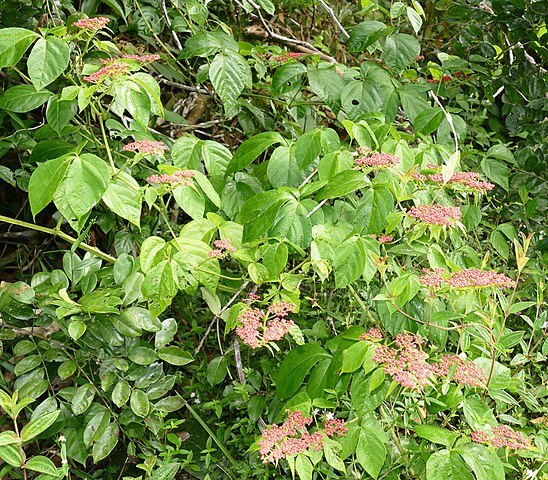

You may also be interested in:
- Opuntia - photo of a cactus, useful properties, home care, description of species, use of a flower in cosmetology and for weight loss, reproduction, flowering time, growing from seeds, watering
- Metrosideros - photo, home care, how to propagate a tree, flowering time, reproduction - growing indoor plants from seeds, keeping temperature, lighting, watering frequency and soil composition
- Calathea - a photo of a flower, home care, why leaves dry near room calathea, transplant, flowering a plant at home, how to care, signs, varieties
- Scindapsus - flower photo, scindapsus care at home, types of indoor plants, signs, flower reproduction, soil for growing, flowering
↑ Up,
Description of the origin and appearance of "indoor grapes"
Cissus is a vine native to the noble family of grapes (Vitaceae). But nature has deprived him of tasty fruits, but rewarded him with other virtues. Beautiful, lush, patterned greenery is the main decoration of the cissus. In addition, this plant is distinguished by an undemanding and docile disposition. Cissus adapts to almost any environment.
In the south, hedges are formed from this liana; in countries with colder climates, it is grown as a houseplant.Decorators often use cissus for vertical landscaping of office and commercial premises, various institutions. A green wall or pillar makes any interior attractive. For its lush, bright greenery, cissus is highly valued by amateur flower growers from different countries. They call it simply - home grapes, and in Russia they affectionately christened it a birch. The leaves of the rhomboid cissus resemble a carved leaf of the Russian white-stemmed tree itself.
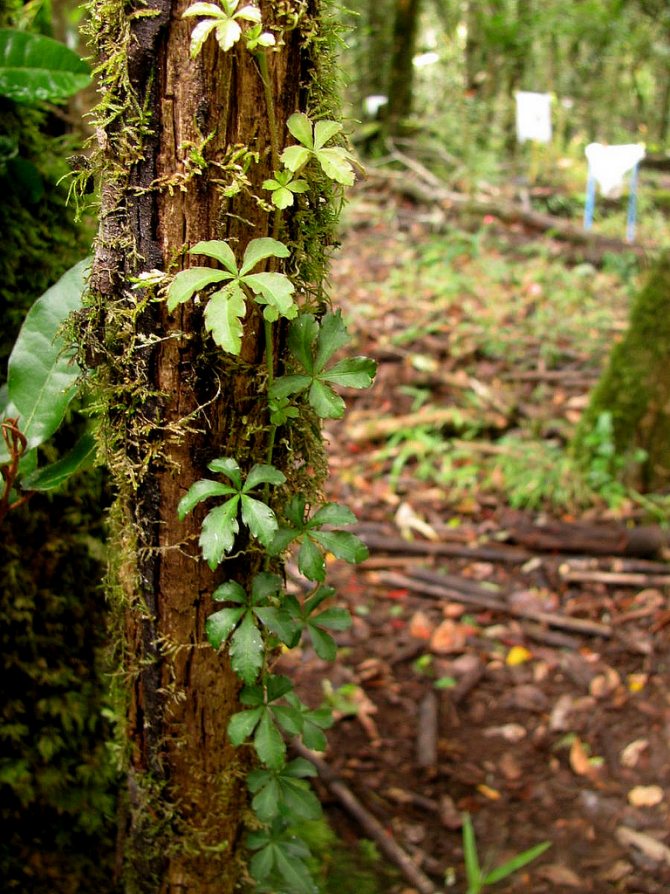

In the tropics and subtropics, cissus turns green all year round, long vines twine around tree trunks
In central Russia in the open field, cissus, of course, will not survive. Wild varieties of this vine prefer humid and warm climates. They inhabit tropical and subtropical forests of all continents. Evergreen Cissus is a shrub that crawls on the ground or climbs trees. For movement, he has a special device - antennae or aerial roots.
Cissus stems are thin, elastic, flexible, up to 3 meters long. Leaves are glossy, often dark green, reddish or spotted. Cissus blooms can be seen in the wild. The buds are collected in umbrellas of an expressionless whitish color. Then brushes of small fruits are formed. When grown in a pot, cissus rarely blooms.
Its main value is a lush and patterned, bright green (in some varieties, motley) cap of leaves. It is overgrown with young greenery very violently. Plant it in a hanging planter, and shoots will hang picturesquely from there. Give support - he will turn it into a beautiful green pillar. Pull rows of twine near the pot, it will climb up, clinging to its antennae, and then an emerald curtain will close the wall or window. Leave the cissus alone, providing a wide container, it will creep along the ground and then hang over the edges of the pot. There are many options, just use your imagination, and the plant will appreciate it.
Cissus is striking in its rapidity of growth. This vine has been recognized by flower growers as one of the easiest to care for and unpretentious. Even those who regularly die of cacti can cope with an easy task without any problems.
Photo gallery: cissus in the interior
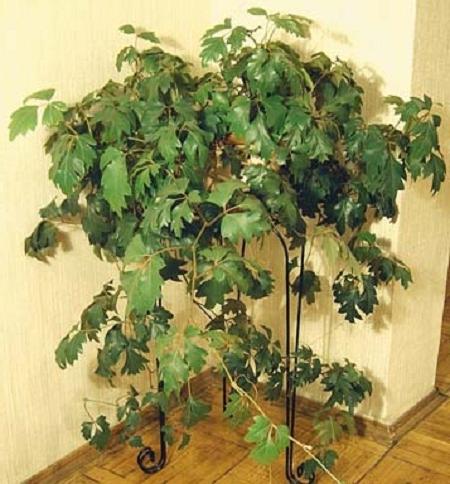

Cissus is not picky, so it is quite possible to place it in the back of the room.
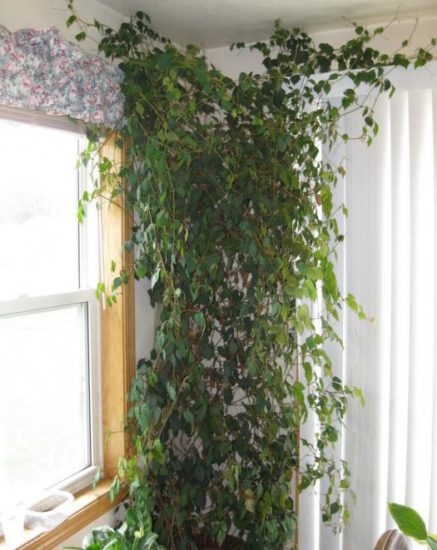

This green "wall" can be created by pulling several pieces of wire in parallel
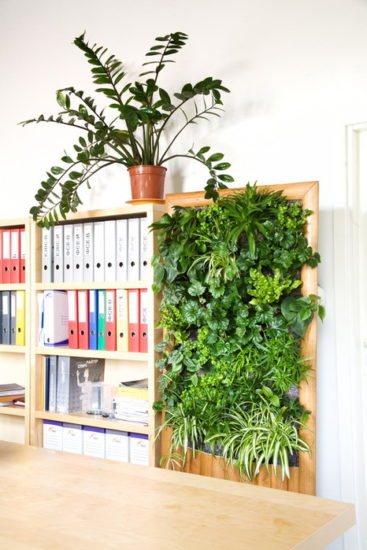

A little imagination, and you can find very interesting interior solutions
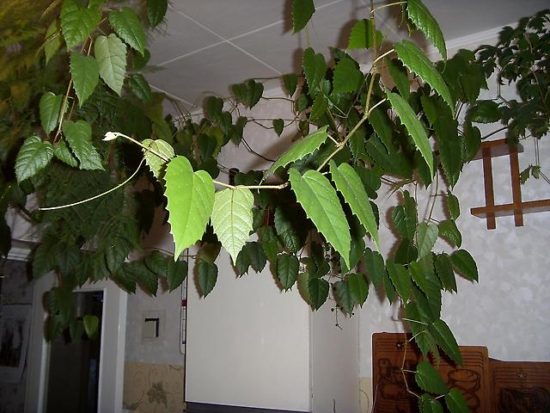

Liana on the ceiling turns an ordinary room into a "branch" of the jungle


Ecostyle is not only beautiful and effective, but also useful
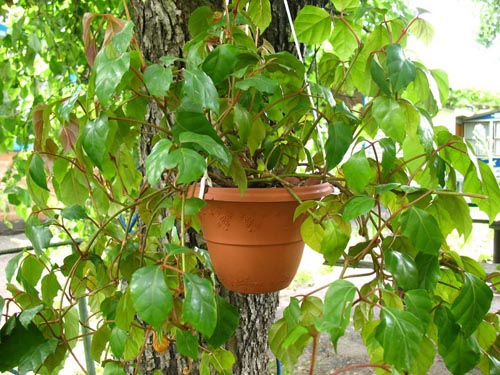

Cissus is ideal for ampel cultivation
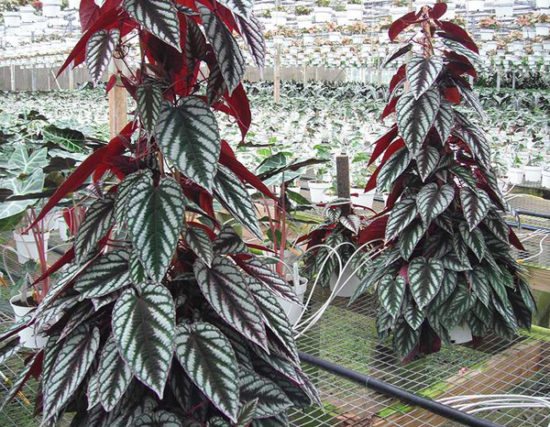

Where the climate permits, cissus is widely used in landscape design.


Cissus is widely used by office designers
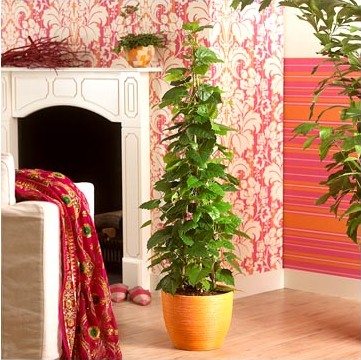

Cissus will decorate any interior
How cissus differs from roicissus
These plants are often confused, which is not an accident. They belong to the same family - the Vinogradovs. But the variety of Rocissus is not so great - only about 12 species. It has long shoots with many branches. The shape of the sheet is rounded. Distributed in Central Tropical Africa. The most famous type of Rocissus grown indoors, by the way, is quite rare - Cape. And the rhombic roicissus, which is confused with rhombic cissus, is practically not grown in culture.
Roicissus, like cissus, is an unpretentious plant. The cultivated species adapt very well at home. Shade, high and low temperatures are easily tolerated.
Harmful insects affecting the plant
Cissus, properly cared for, has good immunity. He rarely gets sick and suffers from insect attacks. But infections and pests can enter the house along with other plants. Scabbards, aphids and spider mites can harm cissus.
Table: how to recognize and control pests
| Pest | How to recognize | Way to fight |
| Aphid | Small insects of yellowish-green or black-brown color, live in colonies. Young soft shoots and leaves are affected. |
|
| Shield | Brown, harsh plaques on the underside of the leaves along the veins. With severe damage, they turn yellow. |
|
| Spider mite | Small insect, sucks juice from leaves, settles on the underside. The leaf is covered with yellowish spots and dots, sometimes a white cobweb is visible on the plant. |
|
Photo gallery: pests threatening cissus
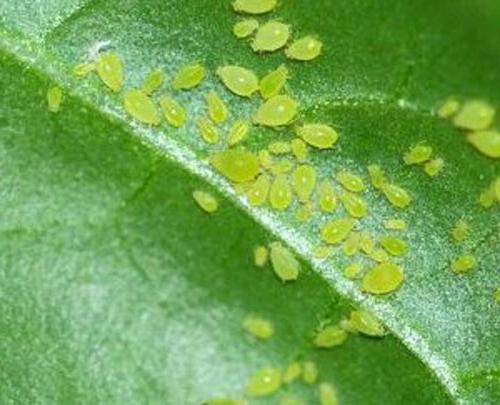

Aphids are one of the most "universal" pests of indoor plants, she also does not disdain with cissus. The strong shell of the scale protects it from most folk remedies, so it is better to immediately use insecticides
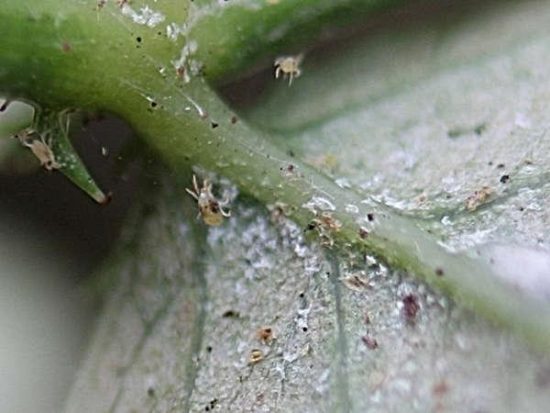

A spider mite is not an insect, therefore special preparations are used against it - acaricides
Useful properties, signs
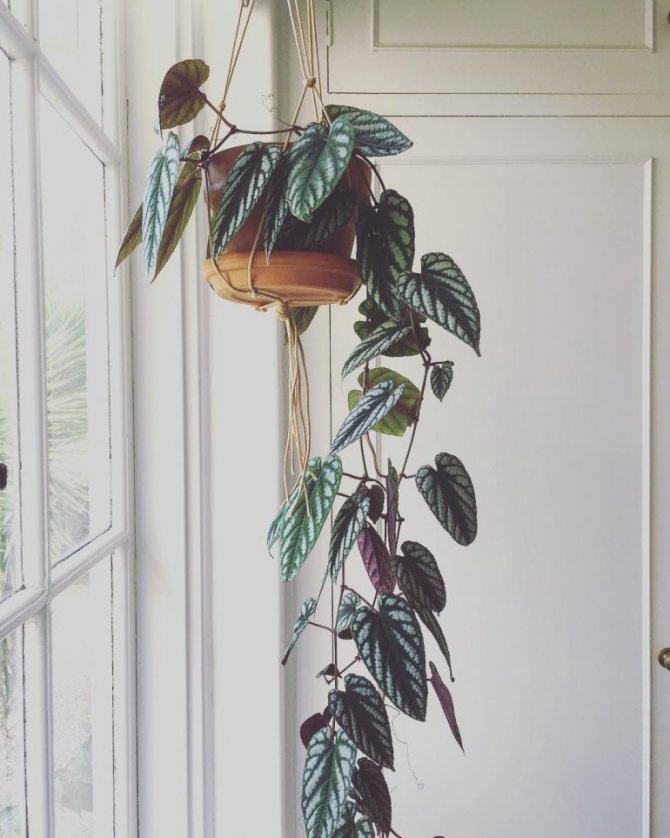

Cissus multicolored. Photo
Cissus humidifies the air in the apartment, saturates it with useful phytoncides. A person who breathes this air works better and gets tired less. Phytoncides fight allergies. In addition, the leaves of the plant absorb formaldehyde.
Interesting! Some growers believe that cissus - "muzhegon", promotes male infidelity.
Pests
Cissus is a hardy plant, but care mistakes can weaken it. At such times, pests pose the greatest threat. In order to notice their appearance in time and protect cissus from problems, you should carefully examine the plant and follow the rules for care.
How to deal with pests - table
| Pests | Signs | Control measures | Prophylaxis |
| Shield | The body of the pest is covered with a scutellum that looks like a brown tubercle. Young individuals can move, but adults cannot. They feed on the sap of the plant, taking away the strength from the latter and suspending its growth. The affected parts of the cissus dry up and fall off. | Carry out treatment with Fitoverm or Aktara preparations. The dosage is indicated on the package. Spraying is carried out 2-3 times in 7-14 days until the complete disappearance of the pests. |
|
| Mealybug | A close relative of the scale insect can be detected with the naked eye. These white hairy insects feed on the sap of shoots and leaves, which greatly inhibits the development of the plant. | ||
| Spider mite | A cobweb appears on the inside of the leaf, on which ticks sit. They feed on cell sap. Stains form at the puncture site. |
|
Photo gallery: how to recognize a pest
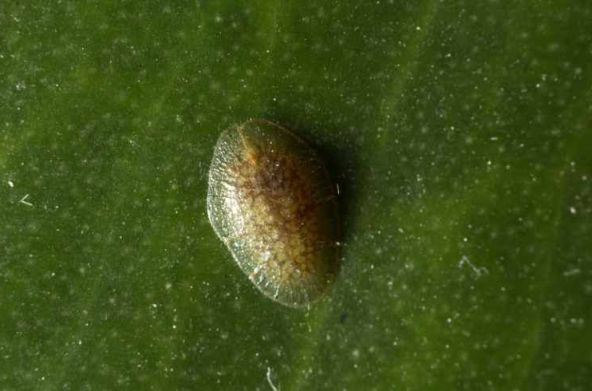

An insidious pest is hiding under the shell - a scabbard
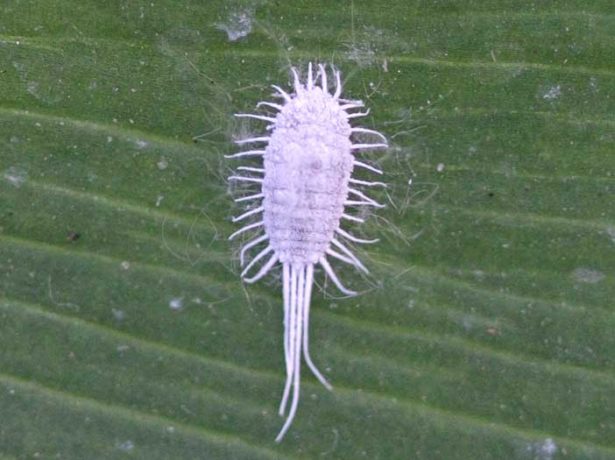

Mealybug - a close relative of the scale insect
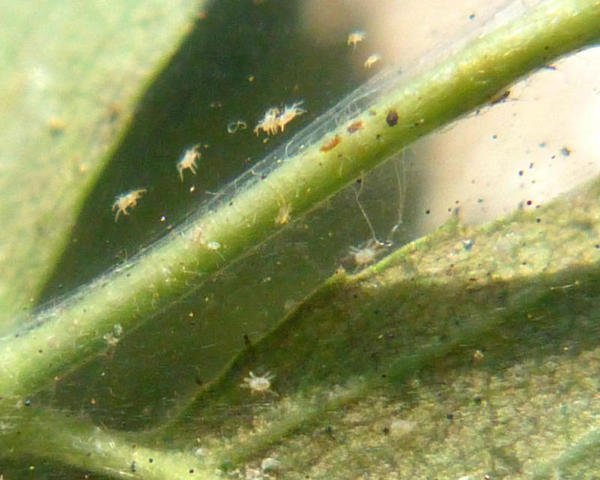

Spider mite braids young shoots and leaves with cobwebs
Types of indoor cissus
In nature, there are more than 300 species, but much less domesticated. It:
- quadrangular (cactus) - shoots are thick, about 1 cm in diameter, tetrahedral (hence the name). The leaves are in three parts, small, fall off quickly. The species is photophilous, it grows rather slowly.
- bicolor (multicolored) - a climbing shrub with elliptical leaf blades covered with silvery specks, with a purple tint. The flowers are yellow, collected in umbrellas.
- Antarctic - the leaves have the shape of an elongated heart, herbaceous green. The flowers look like little green umbrellas.
- rhomboidal - a fast-growing liana, requiring support, thin shoots, complex leaf blades, consist of three diamond-shaped parts. The whole plant is covered with reddish pile, which increases its decorative effect.
Features of seasonal care
There are no significant differences in the care of cissus in different seasons. These can be insignificant adjustments in watering, dressing, temperature of the content.
Features of cissus care, depending on the season:
| Season | Temperature | Watering and humidity | Top dressing |
| Spring Summer | Comfortable for a plant at a temperature of + 19-25 degrees. | Water regularly, but avoid stagnant water. In the summer, regular spraying and warm showers are helpful. | From March to September, apply mineral fertilizers once every 1-2 weeks. |
| Autumn winter | Optimal for keeping + 16-18 degrees, for some species + 10-12 degrees. | The number of waterings is reduced. Refrain from spraying until heating is switched on in cool conditions. | In winter, the plant slows down its growth and the need for feeding is reduced. If the cissus is not at rest, then rare feeding can be saved. |
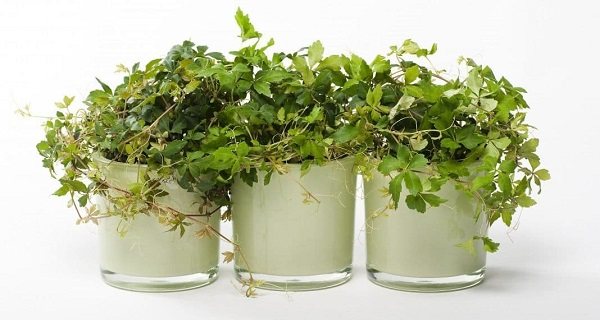

Care advice
Cissus is an unpretentious plant and, with proper care, grows quickly and pleases with an abundance of juicy bright green shoots with beautiful leaves.
Site selection and temperature
It is very important to place the birch in the right place. With the exception of some species, cissus is a shade-loving plant that is completely bright sunlight is contraindicated.
It can grow away from windows or on the east, west and north. If there is not enough natural light, you can add artificial light - cissus is won't hurt.
Birches are quite thermophilic, and feel great at temperatures up to + 25 ° C. The lower limit is + 5 ° C, provided that it is a short period, no more than 2-3 days. But constant drafts are destructive for them, and often lead to death. Optimum temperature content - + 16-19 ° С.
For the winter, it is better to place the bush in a cool room - from 12 to 15 ° C. In spring and summer, you can take it outside, placing it on a balcony, loggia or in the front garden. The exception is multi-colored, which does not tolerate drafts and temperature drops below 15 ° C.
Watering
During the period of active growth in spring and summer, regular and abundant watering of the birch becomes the main condition its health and excellent appearance, because cissus has a large number of leaf blades that evaporate a lot of moisture.
The soil in the pot must be constantly wet, do not dry out (but without stagnation of water on the surface).
In winter, waterlogging of the plant should be avoided, which at this time hardly growingespecially in cool rooms. Watering should be moderate, only after the outer soil layer has dried.
Filling the plant, of course, is not worth it. For watering and spraying, they use settled non-rigid water. You need to spray regularly, at least 2-3 times a week, especially young plants. Bathe periodically under a warm shower... In winter, these water treatments can be replaced by wiping branches and leaves with a damp soft cloth.
Top dressing
Cissus consumes a lot of minerals and nutrients, therefore, needs constant systematic feeding. For this purpose, you can use fertilizer complexes for decorative, non-flowering and deciduous indoor plants once every 7 to 10 days. Top dressing is carried out from March - April to September.
Read about the features of caring for indoor bulbous plants in our article.
Optimal soil composition
Mix equal amounts of humus, turf, peat, leafy earth and sand. The substrate should be neutral or slightly acidic, containing humus.
Transfer
Plants under the age of five should be transplanted annually, changing the container to another, larger one. Older flowers are transplanted with a break of 2 years, since intensive growth and development cease by this age.
For planting cissus, it is better to choose a clay (ceramic), well-breathing pot that allows air and moisture to pass through the walls. Pour 2-3 cm of drainage from pebbles and expanded clay to the bottom. Instead of soil you can use hydroponic.
In order for the old soil to lag well behind the roots by the time of transshipment, the plant must be thoroughly moistened. Then turn the pot over, knock out the contents, being careful not to damage the roots. Water the transplanted birch and leave for 2-3 days in a dark place. The transplanted plant does not need top dressing.
In addition, in the spring you need to do sanitary pruningremoving stems without leaves. This procedure rejuvenates the plant. Pinch the top if you want to increase the bushiness of the cissus.
Reproduction
Cissus is a plant that can be propagated in several ways:
- seeds;
- cuttings;
- dividing the bush;
- layering.
Seeds
The seeds that give the best germination are those of the arctic cissus.
- From April to May, they are sown in flat round pots, shallowly embedded in the ground.
- Cover the bowls with a plastic bag.
- Aired and kept moist.
- When a couple of leaves appear on the sprouts, they are dived into separate pots.
The conditions for the growth of young plants are the same as for adults.
Cissus seeds can also be germinated in peat tablets
Cuttings
Reproduction using cuttings is perhaps the most popular method. Moreover, the cuttings root perfectly both in water and in soil mixture.
- To obtain a new plant, a 10 cm long stalk with several leaves is cut with a sharp knife.
- In a small (8 cm) pot filled with a sand and peat mixture, 3 or 4 cuttings are planted at once.
- The landing container is covered with a glass jar or bag and kept at a temperature of 20 to 22 ° C and at high humidity.
The place should be bright, but without direct sun.
- After 3 weeks, the roots appear and the plants are planted in separate pots. But you can plant several rooted cissus in one container. And then the plant will grow more luxuriant.
You can propagate cissus using cuttings at any time of the year, but preferably in spring or summer.
Cuttings root in water at a temperature of 14–18 ° C.
By dividing the bush
This method is used in spring, replanting an overgrown plant into a new container. The cissus extracted from the pot is divided very carefully into the required number of parts, each of which must have a formed root system and an adult shoot.
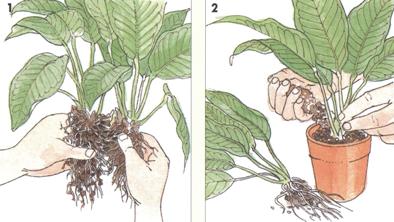

This way the cissus can be split during transplant.
Immediately after dividing, each part is planted in a separate prepared pot.
Layers
You can propagate cissus using cuttings at any time.
- An adult healthy shoot is chosen, which is fixed in a nearby pot in a suitable soil.
By deepening the shoot in several places, you can get several new plants.
- As soon as the rooted shoot has grown the root system, it is cut off from the mother plant.
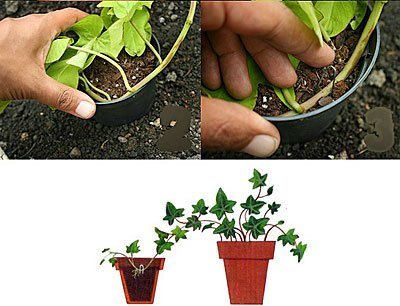

Cissus can be propagated by layering.
Characteristics of the variety and species diversity
Cissus is a creeping shrub belonging to the group of ampelous plants. The stems are elastic, curly, the leaves are bright green and have a shiny surface. At home, it rarely blooms, mainly with white or cream flowers. Sometimes it bears fruit. In natural conditions, there are more than three hundred species of cissus. Only a few are adapted for indoor cultivation.The most common ones are: rhomboid, Antarctic and quadrangular species.
The rhomboid species is the most popular among flower growers. It is unpretentious in care and grows quickly enough. South America is considered to be the homeland. The plant is characterized by vigorous and rapid growth, while clinging to any support. The leaves are bright green, serrated, of medium size, reminiscent of grapes. This species is most often called grape ivy. The stems are flexible and thin, thanks to them the plant not only spreads to the sides, but also rises up.
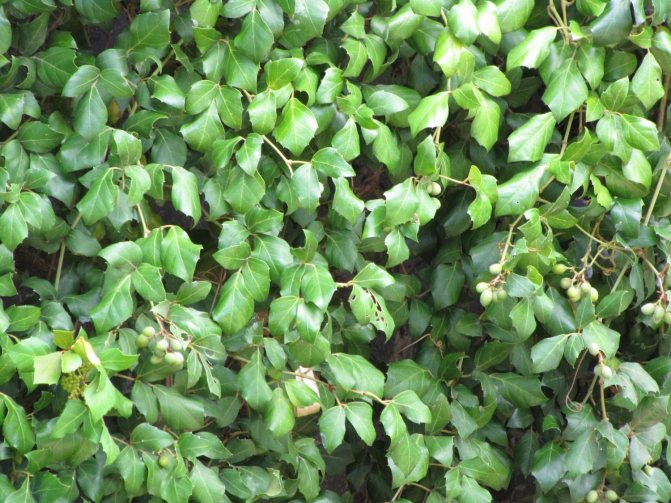

Cissus rhomboid
In nature, this species can reach five meters, forming a dense deciduous mass. Among the representatives of rhomboid cissus, there are many popular varieties - Ellen Danica, Mandiana, Fiona.
The Antarctic cissus species is slightly less popular. His homeland is Australia. Under natural conditions, the stems of the plant become lignified; in apartment conditions, the shoots do not lose their flexibility and elasticity.
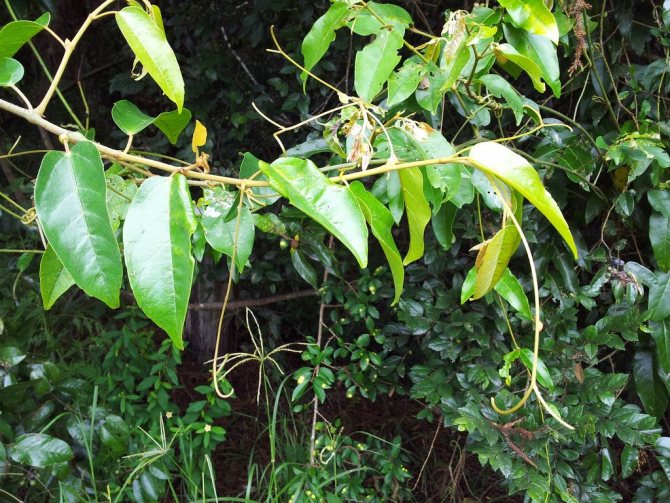

Antarctic cissus
Cissus antarctic has oval, bright green leaves with jagged edges. Their size can reach 11 centimeters. Shoots and antennae are fleecy, due to this they have a brown tint. In nature, it blooms and bears fruit. The fruits are suitable for nutrition, but irritate the mucous membranes.
Cissus quadrangular is of Indian origin, found in Sri Lanka, southern Asia, partly in Africa and Arabia, grows in the southern United States and South America. It grows up to one and a half meters, and the leaves reach 10 centimeters. Flowers are painted in light shades. Bears fruit in small round red fruits.
Cissus quadrangular
Its medical use has been known for a long time. This plant was used to treat sprains, fractures, joint injuries, and was also used as an anesthetic.
In addition to those listed, there are a great many varieties of decorative grapes: cactus, glandular, striped. However, they are practically not represented in the collections of amateur flower growers.


